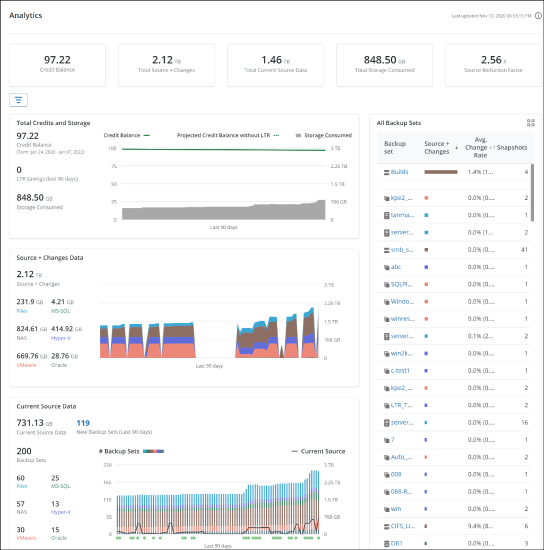Archived release notes and fixed issues 2020
Note: These are archived release announcements, and some links might be inactive.
December 21, 2020
New Features
Backup management on OEM simplified with Phoenix Backup Store
Druva now lets organizations configure Phoenix Backup Store with Oracle Enterprise Manager (OEM) to simplify database backup management on the Oracle RMAN Database hosts in their data centers and in the AWS Cloud. You can now schedule and manage backups on the Oracle RMAN Database hosts in the data center and in the AWS Cloud using the OEM. It also simplifies the script management process during backups and lets you run customized scripts during the backups. For more information, see Configure Oracle Enterprise Manager with Phoenix Backup Store and Template scripts for configuring OEM.
Enhancements
Extended support for DRaaS operating system
With the release, the following operating systems are supported:
- SUSE Linux Enterprise Server 12 SP 5
- Fedora 31, 32, 33
- CentOS 8.1, 8.2
- Red Hat Enterprise Linux (RHEL) 8.1, 8.2
For more information, see DRaaS support matrix.
Customer action required: Upgrade the Phoenix AWS Proxy to version 4.9.2-104913 and the VMware backup proxy to version 4.9.2-104913. You can download the Phoenix AWS Proxy from the Downloads page.
Extended support for DRaaS failover instance types
With the release, the following instance types are supported for failover:
- Compute optimized: c5.large , c5.xlarge , c5.2xlarge , c5.4xlarge , c5.8xlarge
- General: m5.xlarge, m5.large , m5.2xlarge , m5.4xlarge , m5.10xlarge , m5.16xlarge
For more information, see DRaaS support matrix.
Customer action required: None
IAM role selection enhancement for DRaaS
With the implementation of AWS PrivateLink (If you have deployed a Phoenix AWS proxy version 4.9.1-101573 or later), when you create a new DR Plan, add VMs to a DR plan, or when you update failover settings, only the existing IAM roles will be displayed in the IAM Role drop-down. If you have created a new IAM role in your AWS account, you need to manually type the name of the IAM role which is the IAM instance profile ARL name.
Create a DR plan
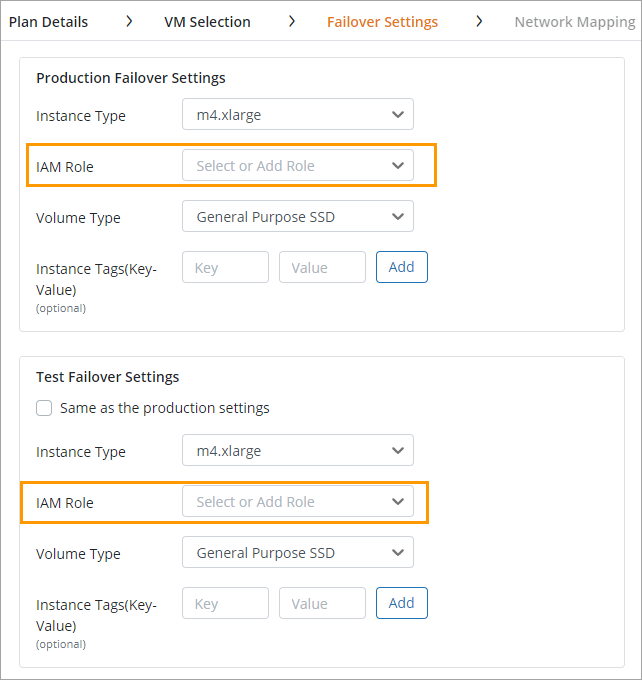
For more information, see Create a DR plan.
Add VMs
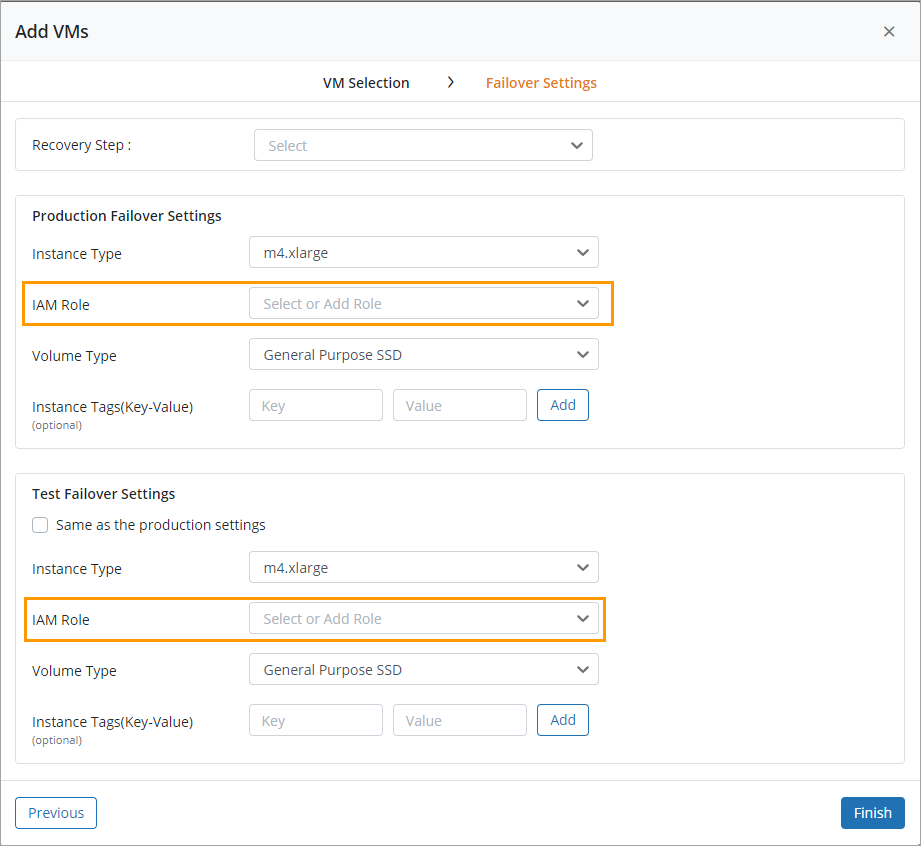
For more information, see Manage Virtual Machines.
Failover settings
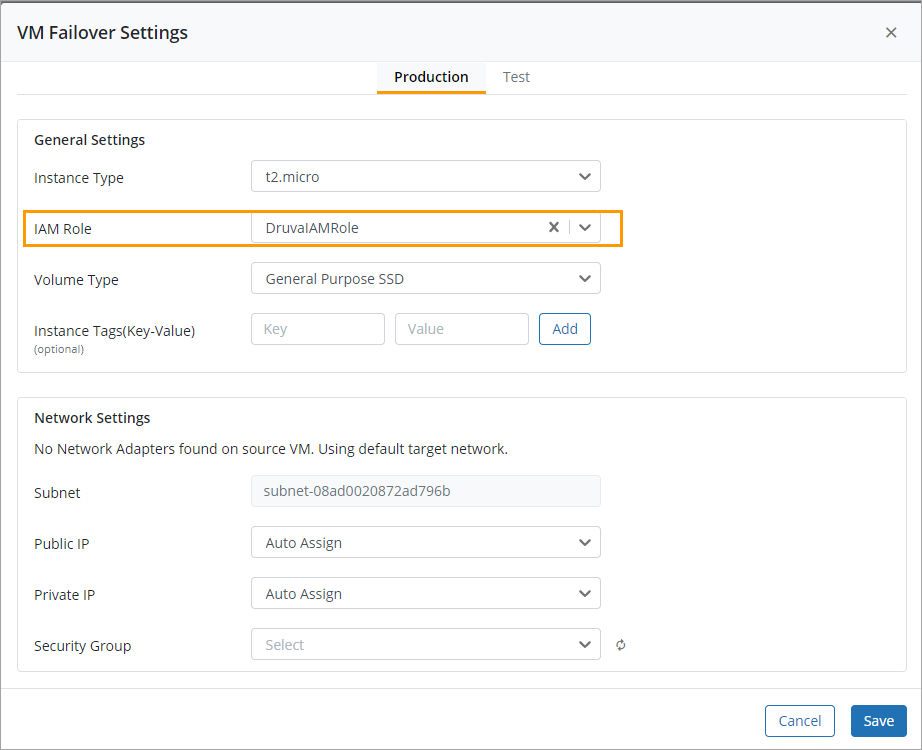
For more information, see Manage disaster recovery failover.
Customer action required: None
Enhanced user interface for VMware backup policy creation
The VMware backup policy creation user interface is enhanced for easier operations. Also, you can now schedule backups at hourly intervals.
For more information see, Manage backup policy.
New access point

Backup policy creation wizard
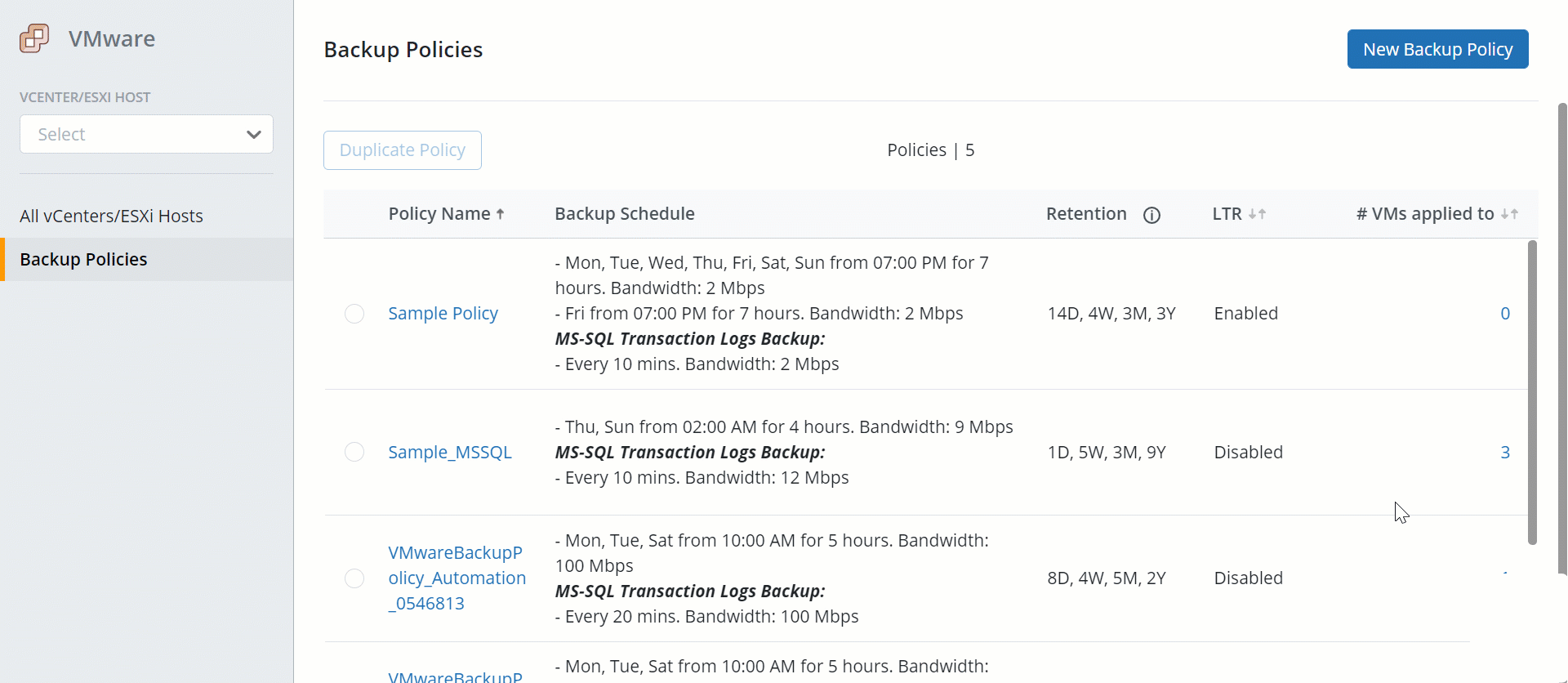
Backup policy management

Enhancements to MS SQL application-aware database restores
For VMware workloads, for restoring MS SQL application-aware restore and now you can:
- Use the same virtual machine for the destination and staging virtual machine.
- Run parallel restores with the same staging virtual machine or destination virtual machines.
For more information, see Restore prerequisites and considerations.
Customer action required: Upgrade the VMware backup proxy to version 4.9.2-104913. You can download the Phoenix AWS Proxy from the Downloads page.
File Server and NAS content rule enhancements
Phoenix will not make any default file type exclusions, or inclusions in the file server and NAS content rules created post 21 December 2020. You can now choose to exclude or include predefined file types, custom extensions, and file name patterns. Phoenix also allows you to make the entered folder paths, extensions, and file name patterns on Linux servers and NFS shares case insensitive.
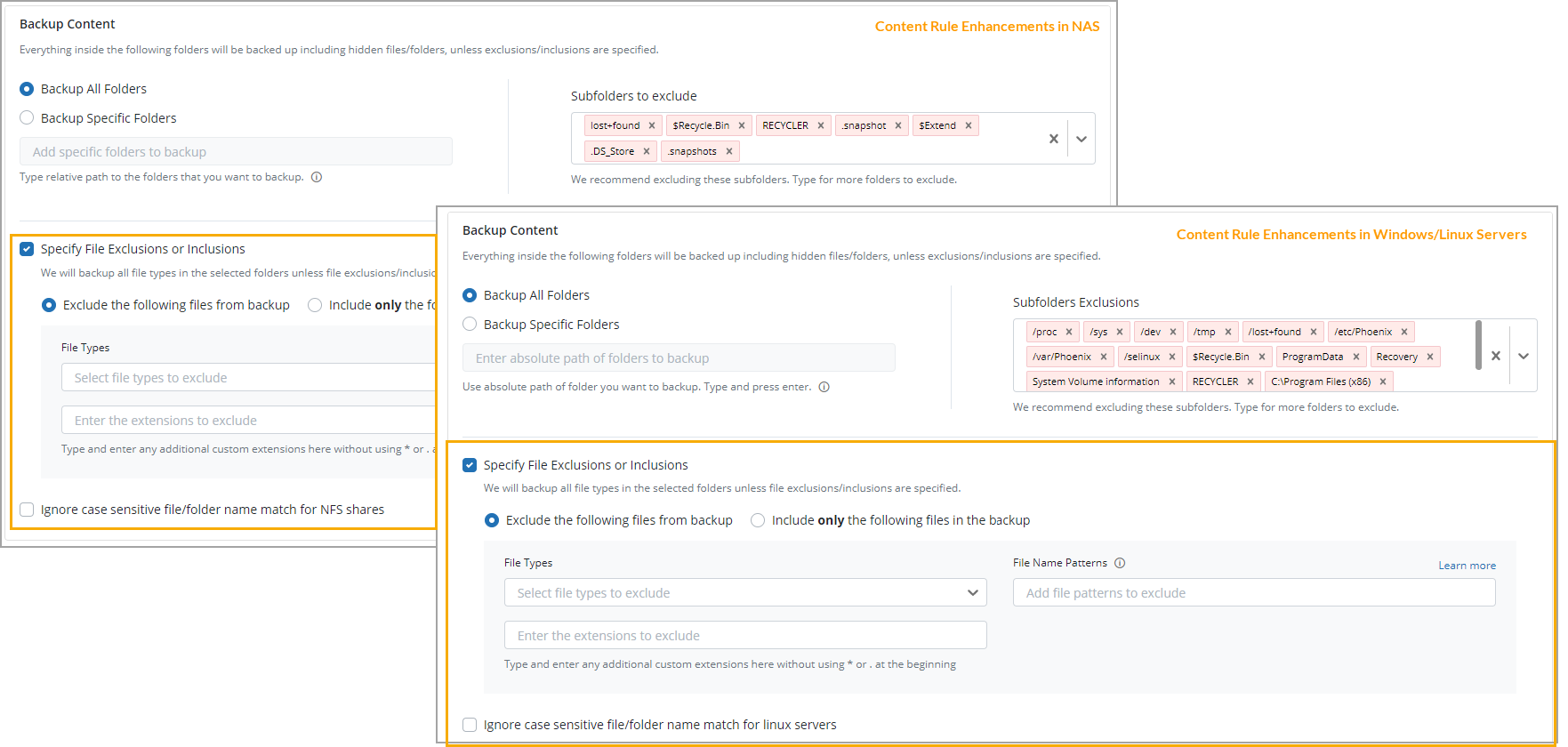
For more information see Manage content rules in file servers and Manage Content Rules in NAS.
Customer action required: Upgrade the Phoenix agent to version 4.9.1-103398 to use the Ignore case sensitive file/folder name path for Linux servers and NFS shares feature.
Enhanced File Server and NAS APIs to return content rule details
We have enhanced the file server and NAS APIs wherein, the BackupContentStruct structure returns the content rule information, such as the list of folders, file types, extensions, and patterns included or excluded from the backup. For more information, see BackupContentStruct and NASBackupContentStruct on the API reference documentation on the Druva developer portal.
Customer action required: No action required.
Support for Amazon FSx for Windows and Amazon EFS
Phoenix now supports Amazon FSx for Windows shares and Amazon EFS shares for backups and restores. You can protect Amazon FSx for Windows shares using a Windows proxy, and protect Amazon EFS shares using a Linux proxy. For more information, see Phoenix support for Amazon FSx for Windows and Amazon EFS
Customer action required: No action required.
Enhanced user interface for MS-SQL Servers
The newly redesigned MS-SQL Servers page in Phoenix has an intuitive user interface that lets you accomplish critical tasks with ease. Some of the key highlights of the new user interface are:
All SQL Resources details page
The redesigned All SQL Resource details page lets you see all the configured backup sets for the instance or availability group at a glance. You can view more details about the configured backup sets, create new backup sets, backup or restore data from this page itself.

Create Backup Set page
The new Create Backup Set page allows you to configure everything required for SQL backup sets from one single place.
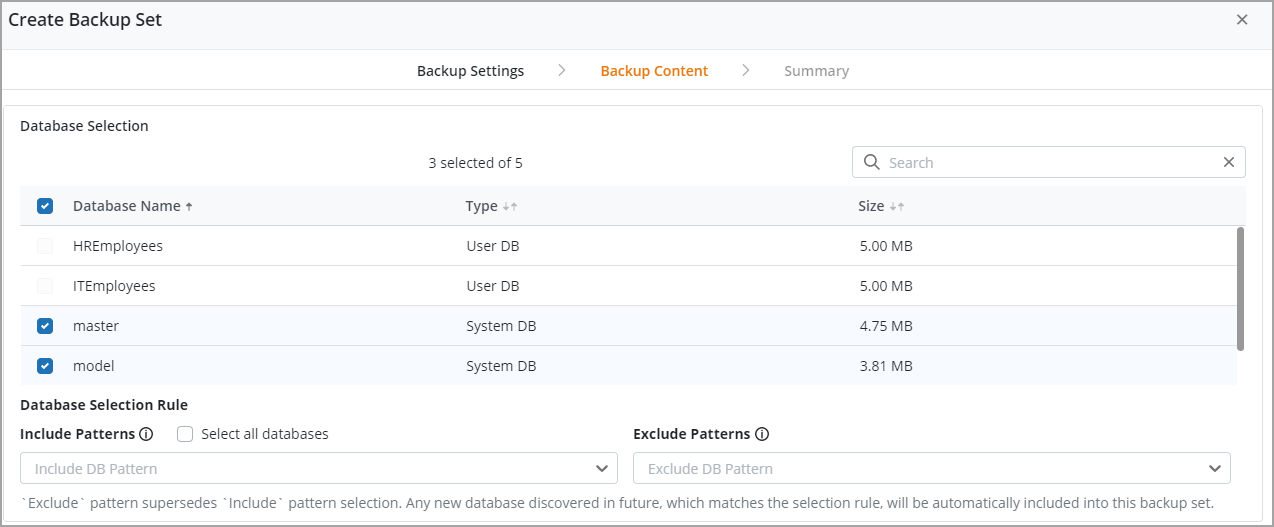
Register New Server page
The newly designed Register New Server page lets you check prerequisites for the SQL agent, download the agent and activate the agent all from a single place.

Backup Policies page
The new SQL Backup Policies page lets you create new policies and duplicate existing ones. This page lists all the existing SQL backup policies.

SQL jobs page
The newly added SQL jobs page lists all the SQL backup, restore and log request jobs. You can see the status of running jobs and details of the completed jobs. You can also filter the SQL jobs by job type, status, and started in.

A new SQL Restore data page
The new restore data page lets you select from a snapshot restore, point in time restore, and a transaction mark restore. Depending upon the chosen restore type, select the other settings and databases and perform a restore.
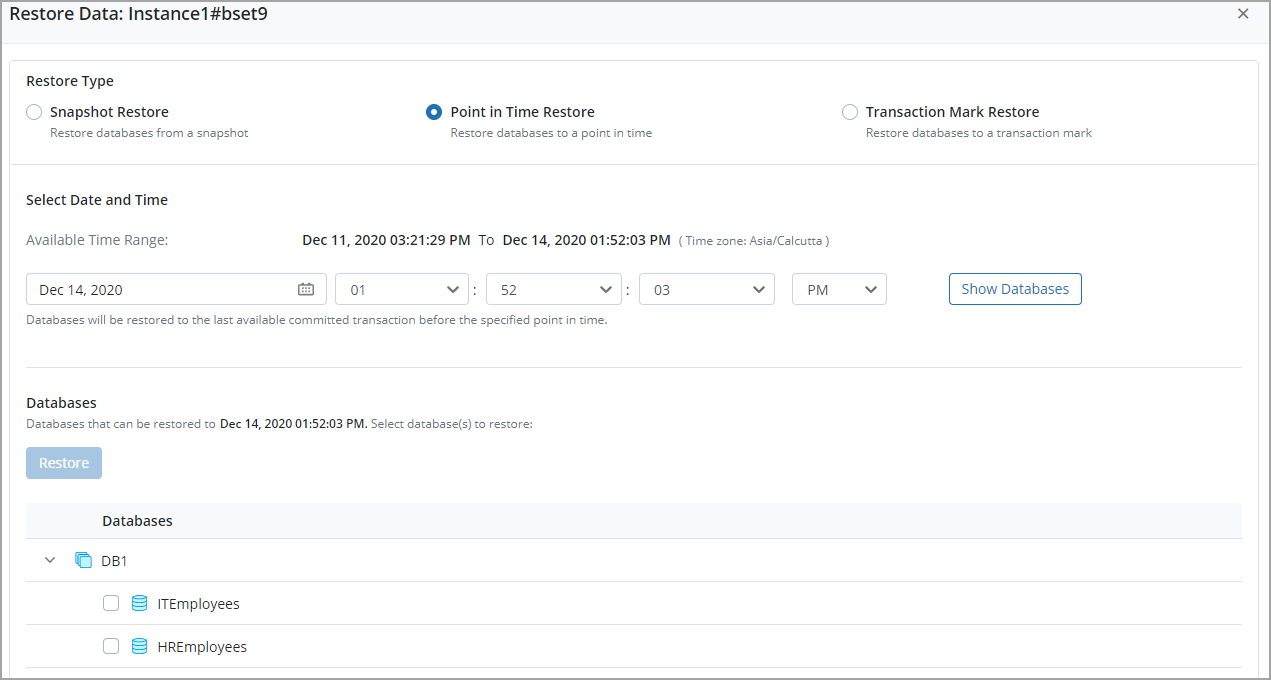
For more information, see
Known Issues
| Issue | Description |
|---|---|
|
PHN-27258 |
The filename patterns File* and File*.extension are unsupported for file server and NAS content rules. For example, do not use a filename pattern like img* to include/exclude all files that start with img. Use *img* instead. Do not use a filename pattern like img*.jpg to include/exclude all files that end with the extension jpg. Enter the file extension jpg under File Types instead |
| PHN-28494 |
While editing a backup set and content rule in File Servers and NAS, if the entered File Name Pattern matches an ID of group name, the File Name Pattern shows the group name instead of the entered text. For example, if the entered file name pattern is exe, the File Name Pattern field populates Executables instead of exe. |
|
PHN-29072 |
Phoenix cannot auto-discover EFS shares. Workaround Manually add the EFS shares. |
|
PHN-25464 |
Unable to backup an EFS share exported at the root directory (/) Workaround Export subfolders on the EFS share. |
|
PHN-28619 |
When you perform the application-aware restore of MS SQL database on VMware, the following error is encountered intermittently. Failed to get get_db_filemap_from_metadata. error code: 4001 The error occurs in case the disk attached to the staging VM is not coming online. Workaround On the staging VM, change the execution policy of the Powershell scripts. Run following commands on Powershell prompt:
|
Revision Information
| Platform | Revision | Public Cloud | Gov Cloud |
|---|---|---|---|
| Windows | 4.9.2-105285 |
|
|
| Linux | 4.9.2-104913 | ||
| VMware Backup Proxy | 4.9.2-104913 | ||
| Hyper-V FLR Proxy | 4.9.2-104913 | ||
| Phoenix Backup Store | Not applicable |
December 7, 2020
Enhancements
Perform application-aware restores of MS SQL databases by upgrading the backup proxy
For VMware, to perform application-aware restores of MS SQL databases, now you need to simply upgrade one of the backup proxies and proceed with the restore. With this enhancement, you no longer need to deploy a fresh backup proxy which was a requirement earlier.
Customer action required: Upgrade the backup proxy to version 4.9.2. For more information, see Upgrade backup proxy.
Fixed issues
| Issue | Description |
|---|---|
|
PHN-25720 |
For VMware, Druva Phoenix now performs application-aware backups for MS SQL databases with special characters (. , / ; : ) in the database name. |
| PHN-27017 | If the actual database name and the AG's database name are the same but differ in case, SQL discovery would fail, causing issues during backup. This is no longer an issue since the discovery of all AG databases is case insensitive. |
Revision Information
| Platform | Revision | Public Cloud | Gov Cloud |
|---|---|---|---|
| Windows | 4.9.1-104323 |
|
|
| Linux | 4.9.1-103398 | ||
| VMware Backup Proxy | 4.9.2_104693 | ||
| Hyper-V FLR Proxy | 4.9.1-103398 | ||
| Phoenix Backup Store | 4.9.2-104711 |
Upcoming enhancements with December 21, 2020 release
Here are some of the upcoming enhancements with the December 21, 2020 release.
Enhanced user interface for VMware backup policy creation
The VMware backup policy creation user interface is enhanced for easier operations. Also, you can now schedule backups at hourly intervals.
New access point

Backup policy creation wizard

Backup policy management

Simplified user experience for MS-SQL Servers
The redesigned MS-SQL Servers page in Phoenix is intuitive and helps you perform critical tasks with ease. You will experience simplified workflows for registering SQL servers, creating backup sets, restoring SQL databases, and much more.
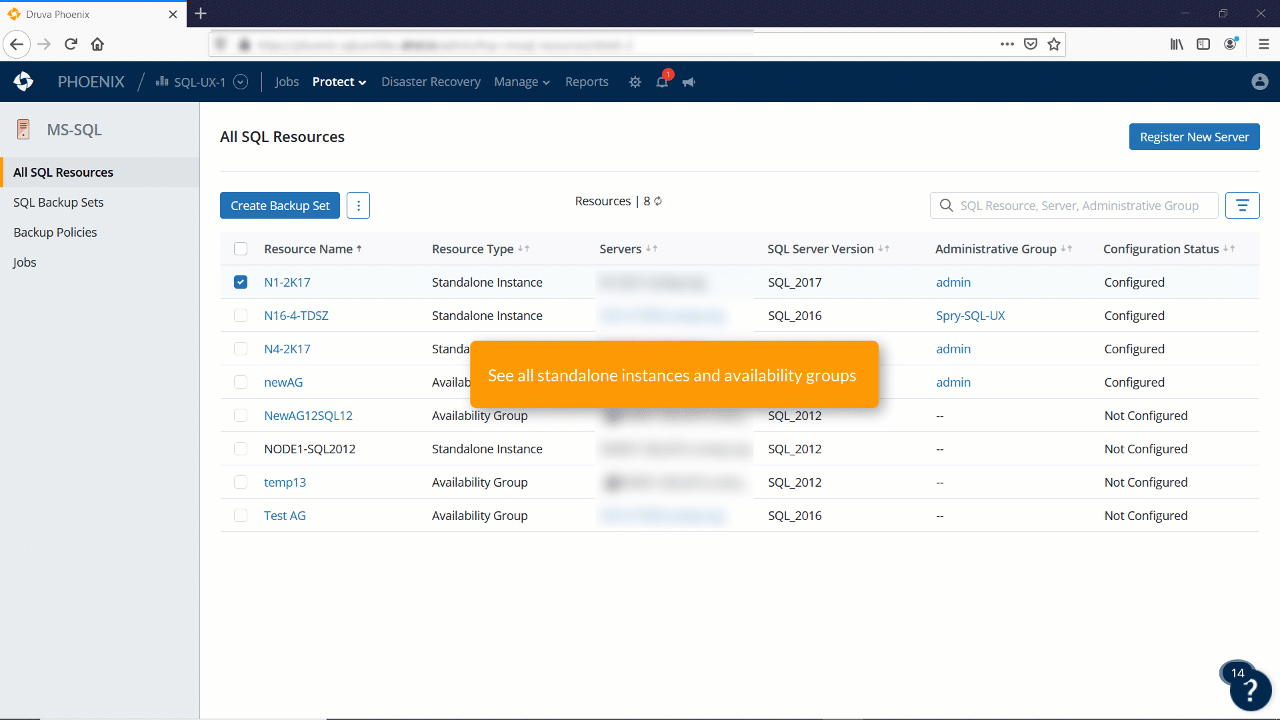
Customer action required: No action required.
November 23, 2020
New Feature
Secure communication for DRaaS through AWS PrivateLink
The communication between AWS services and Druva services used for DRaaS, is now done through AWS PrivateLink instead of the internet gateway.
AWS PrivateLink provides private connectivity between VPCs and services hosted on AWS or on-premises, securely on the Amazon network. By providing a private endpoint to access the services, AWS PrivateLink ensures the traffic is not exposed to the public internet. It also makes it easy to connect services across different accounts and VPCs to further simplify network architecture.
Customer action required: Install Phoenix AWS Proxy version 4.9.1-101573.
When you deploy the Phoenix AWS Proxy, Druva deploys VPC endpoints for required services and deploys a Route 53 hosted zone for the VPC.
This capability is available only with a fresh deployment and not with an upgrade of the Phoenix AWS proxy.
For existing customers, deploy a new Phoenix AWS proxy using the new cloud formation template and delete the existing Phoenix AWS proxy.
For more information, see Deploy Phoenix AWS proxy.
Enhancements
Smart Scan improvements for File Servers and NAS
We have enhanced the Smart Scan user interface so that it is easier for you to decide whether to enable Smart Scan in your backup policy or not. Smart Scan lets you skip files on your Linux file servers and NAS shares that have not changed recently. Skipping these files from backup scans makes incremental backups faster.
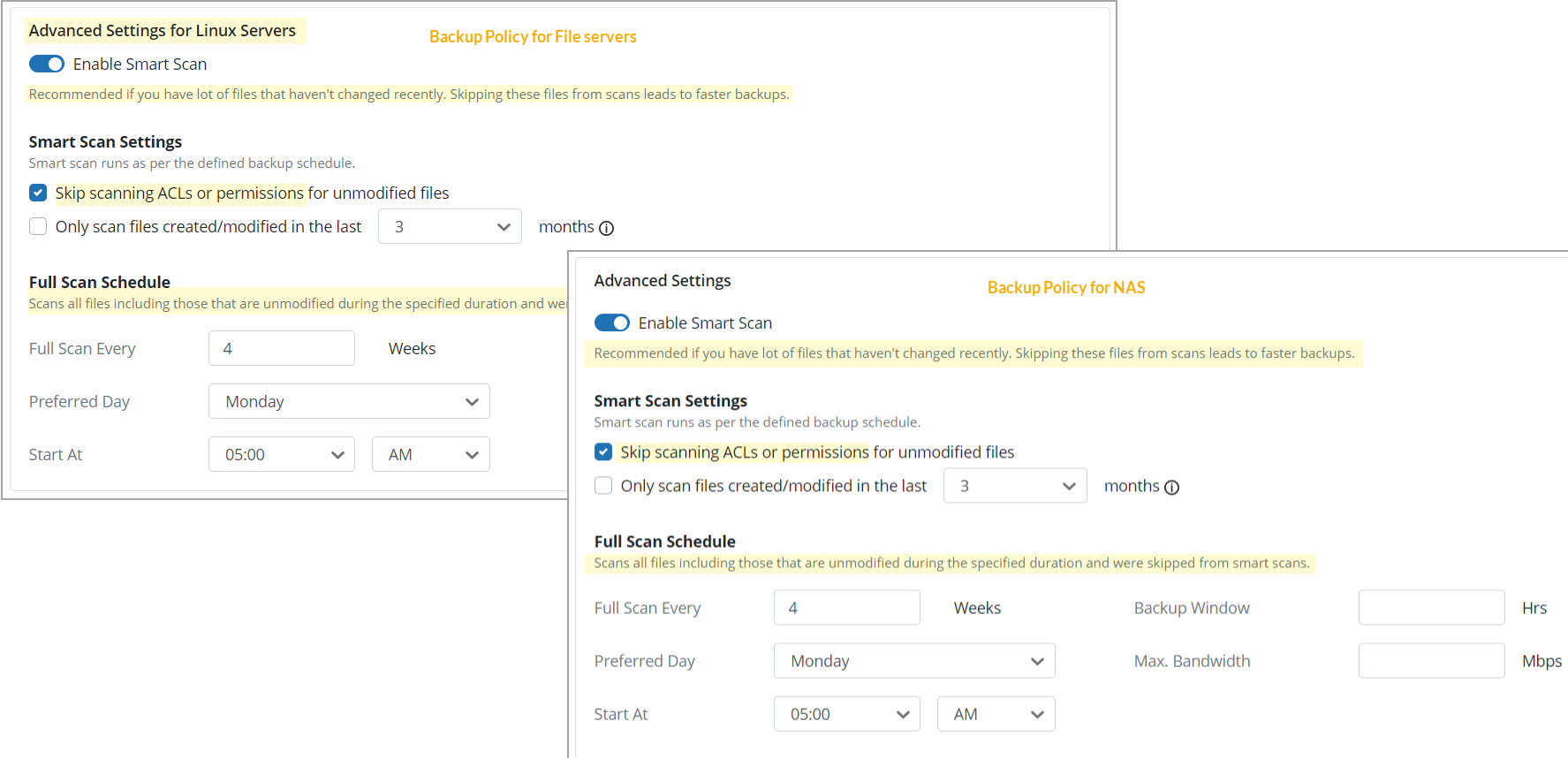
For more information, see Add Backup Policy for file servers and Manage backup policies for NAS shares.
Customer action needed: None.
Better compression algorithm for File Servers and NAS
We have changed our compression algorithm from ZLIB to ZSTD. New Phoenix users (23 November 2020 and later) with File Server and NAS workloads can now experience optimized resource utilization in addition to better compression, reduced storage, and faster backups and restores. Existing users with File Server and NAS workloads can experience these benefits starting in January 2021 but need to ensure that:
-
All the Phoenix agents in their environment (across all workloads) are at version 4.9.0 or later.
-
All the CloudCache agents in their environment are at version 3.9 or later.
Customer action needed: Existing customers with File server and NAS workloads must upgrade all the Phoenix agents to version 4.9.0 or later and CloudCache agents to version 3.9 or later.
Manage your credit limits with an improved Credit Limits feature
This release brings an enhanced credit limits feature for you to have granular control over defining and managing your organization’s credit limits. Credit limits enable you to configure the number of credits that an organization can consume. The updated Credit Limits brings the following new capabilities:
-
Set an expiry date for the credit consumption by each organization
-
Define what happens when the credit limit expires
-
Choose credits that Phoenix recommends intelligently based on your previous usage
For more information on managing credit limits, refer to Credit Limits.
Browse to mount points during SQL restores
You can now browse to mount points while restoring SQL databases to alternate locations.
For more information, see Restore SQL server databases using snapshots.
Enhanced UI for Analytics
We have redesigned the Analytics page that has an intuitive user interface for easier operations.
For more information, see View Analytics page.
Customer action required: None
Expanded support for DRaaS
Phoenix DRaaS now supports the following:
- Ubuntu 20.0
- CentOS :8.0
- Red Hat Enterprise Linux (RHEL) 8.0
- Fedora: 30
- SUSE Linux Enterprise Server: 15.0 SP2
For more information, see DRaaS support matrix.
Customer action required: None
Deprecated Feature
Phoenix End of Support for TLS 1.0
Druva will end the support for TLS 1.0 for Phoenix Clients on November 23, 2020. As you may be aware, TLS 1.0 is now obsolete and is known to have several security vulnerabilities. IETF, as well as several government agencies and global compliance regulations have mandated that TLS 1.0 must not be used.
Phoenix Clients lower than version 4.7.6-47047 use TLS 1.0 and will no longer be able to connect to the Phoenix Cloud. For uninterrupted services, it is mandatory to upgrade to the latest Phoenix Client version supported by Druva. Similarly, Phoenix CloudCache lower than version 3.7-47047 use TLS 1.0 to communicate to the cloud. Please upgrade the Phoenix CloudCache server to the latest version.
Customer action needed: You must upgrade all the configured Phoenix Clients and Phoenix CloudCache to the latest version.
-
If the VMware backup proxy version is 4.7.1 or lower, you need to deploy a new VMware backup proxy.
-
If the VMware backup proxy is 4.7.2 or higher, you can either auto-upgrade or manually upgrade to the latest version.
If the Phoenix Client is installed on Windows Server 2003 (EOL), you need to migrate to the supported platform as per the Phoenix Support matrix.
Revision Information
| Platform | Revision | Public Cloud | Gov Cloud |
|---|---|---|---|
| Windows | 4.9.1-103398 |
|
|
| Linux | 4.9.1-103398 | ||
| VMware Backup Proxy | 4.9.1-103436 | ||
| Hyper-V FLR Proxy | 4.9.1-103398 | ||
| Phoenix Backup Store | 4.9.1-103436 |
October 20, 2020
New Features
Ability to restore individual MS SQL database from MS SQL application-aware backups
You can now restore MS SQL server databases from application-aware backups without requiring to restore the entire virtual machine. You can restore the database to its original location or an alternate location. You can also restore just the database files from a snapshot.
Also, when you perform a full VM restore of MS SQL virtual machines (application-aware), the restored databases will be application-consistent.
Watch this video for a quick process overview;
Note: This enhancement is only applicable to VMware on-premises as the NFS datastore is not supported by VMware cloud.
For more information, see Restore Microsoft SQL Server databases on VMware virtual machines.
Customer action required: Deploy a fresh additional backup proxy and provision a Windows staging virtual machine.
Content Rules in NAS
You can now create content rules in NAS. You can either use existing content rules or specify custom content and save it as a new rule.
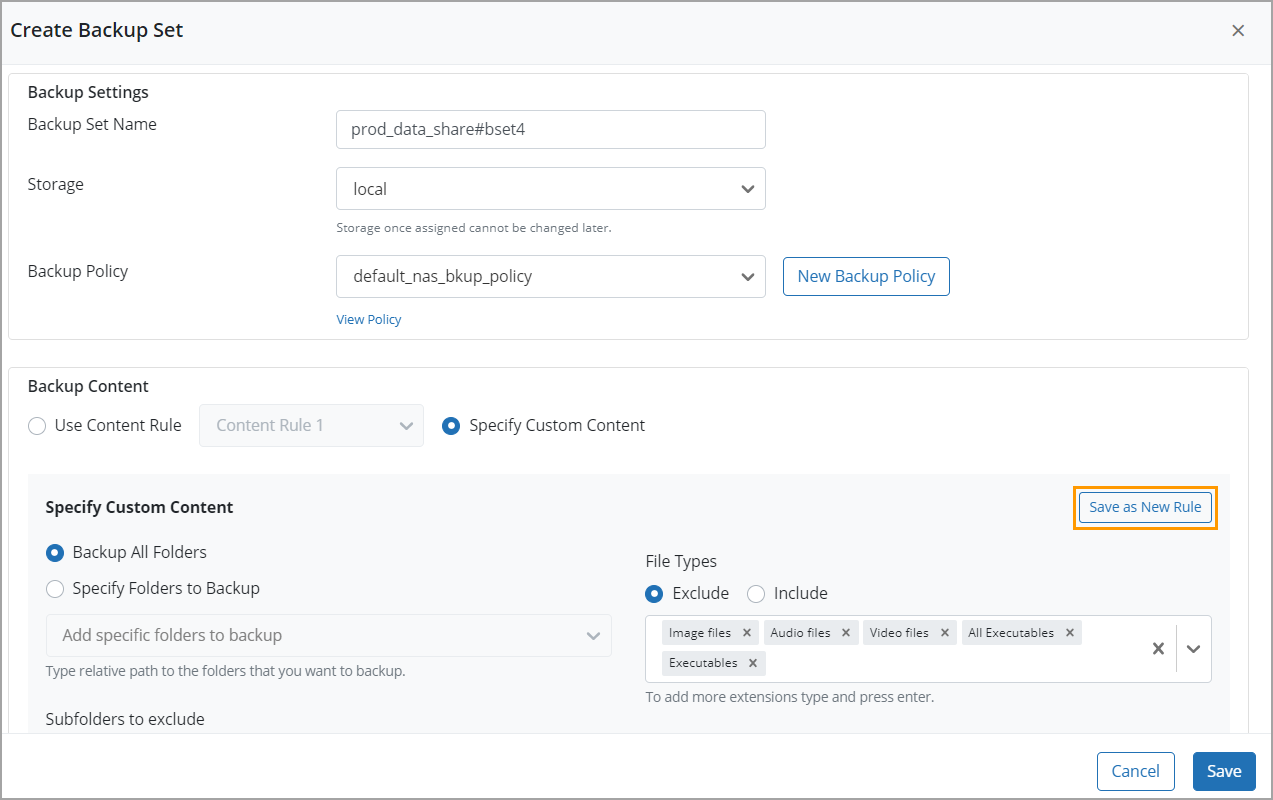
For more information, see Manage Content Rules in NAS
Customer action required: None
Enhancements
Performance and design enhancements to Phoenix Backup Store
This release brings an enhanced version of the Phoenix Backup Store for Oracle Server. The design changes and improvements to the Phoenix Backup Store now provide you with an in-depth experience in reporting and monitoring Oracle backups.
-
Phoenix now gives you complete visibility into RMAN activities. The progress logs now give you a tour of different states of RMAN backup operations. You can track the progress of backup jobs triggered for Oracle databases. For more details, see RMAN backup job details.
-
The enhanced RMAN scripts no longer require the log file directory attribute (logdir) while triggering backup from the command line. The Phoenix Backup Store service running on the Phoenix Backup Store fetches the RMAN log file path specified in the backup mount. You can view the RMAN Log file at the <Local_PBS_Mount>/_workspace/RMAN_Logs/ location. You must not delete, rename, or move the log files from this location.
The new command to run a shell script is ./oracle_rman_data_backup.sh <PBS_IP_Address> <Mount_Name>. -
The new RMAN scripts need to be run without the logdir parameter. If you face any issues with the deployment of new scripts, contact Druva Support.
-
The new, client-side architectural changes to the Phoenix Backup Store significantly improve the backup throughput.
Performance improvement observed during the internal tests performed based on the availability of hardware resources:-
The first backup was 3x faster
-
The incremental backup was 1.5x faster
We recommend you to upgrade Phoenix Backup Store to the latest version to experience the performance improvement.
-
Customer action needed:
-
Upgrade the Phoenix Backup Store to the latest revision.
-
Replace your existing RMAN scripts with the new template scripts provided with this release. The new scripts require the latest Phoenix Backup Store with version 4.9.1 or later. To use the new scripts, see Template shell scripts for Linux and Solaris RMAN hosts and Template batch file and RMAN script for Windows RMAN hosts. The new scripts are also located in the /opt/Druva/Phoenix/PhoenixBackupStore/bin folder on the Phoenix Backup Store 4.9.1 or later.
Your backups will stop running if you upgrade the Phoenix Backup Store to version 4.9.1 or later but miss to replace the old RMAN scripts with the new scripts.
- Run the scripts without the logdir parameter.
Select Phoenix CloudCache (local storage) when you configure a virtual machine for backup
When you configure your virtual machines for backup, you can select local storage to store backups locally by mapping a Phoenix CloudCache.
The option is available when you create or edit an auto-configuration rule or manually configure or reconfigure virtual machines for backup.
For more information, see Getting started with configuring virtual machines for backup.
Auto configuration
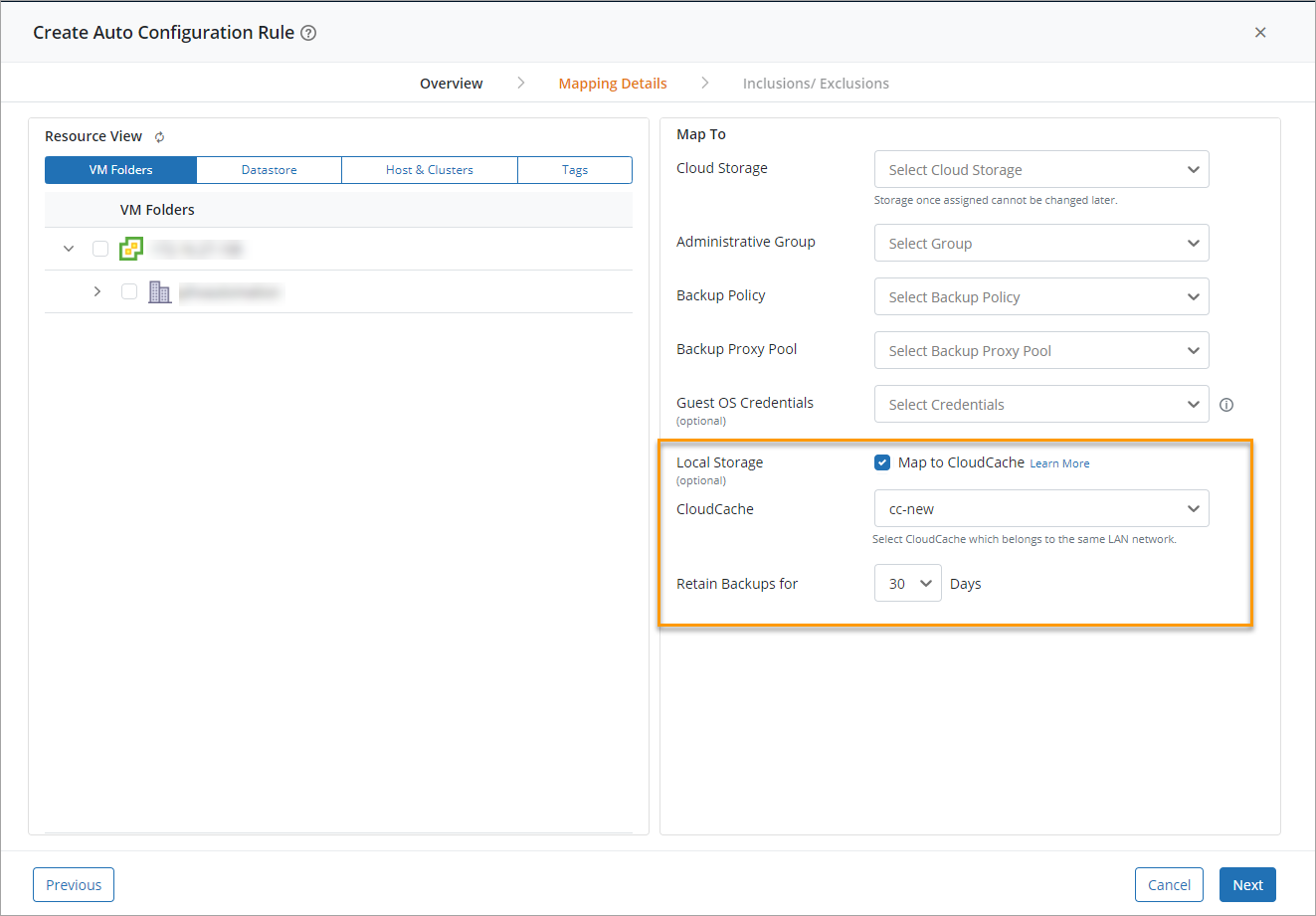
Manually configure virtual machines for backup
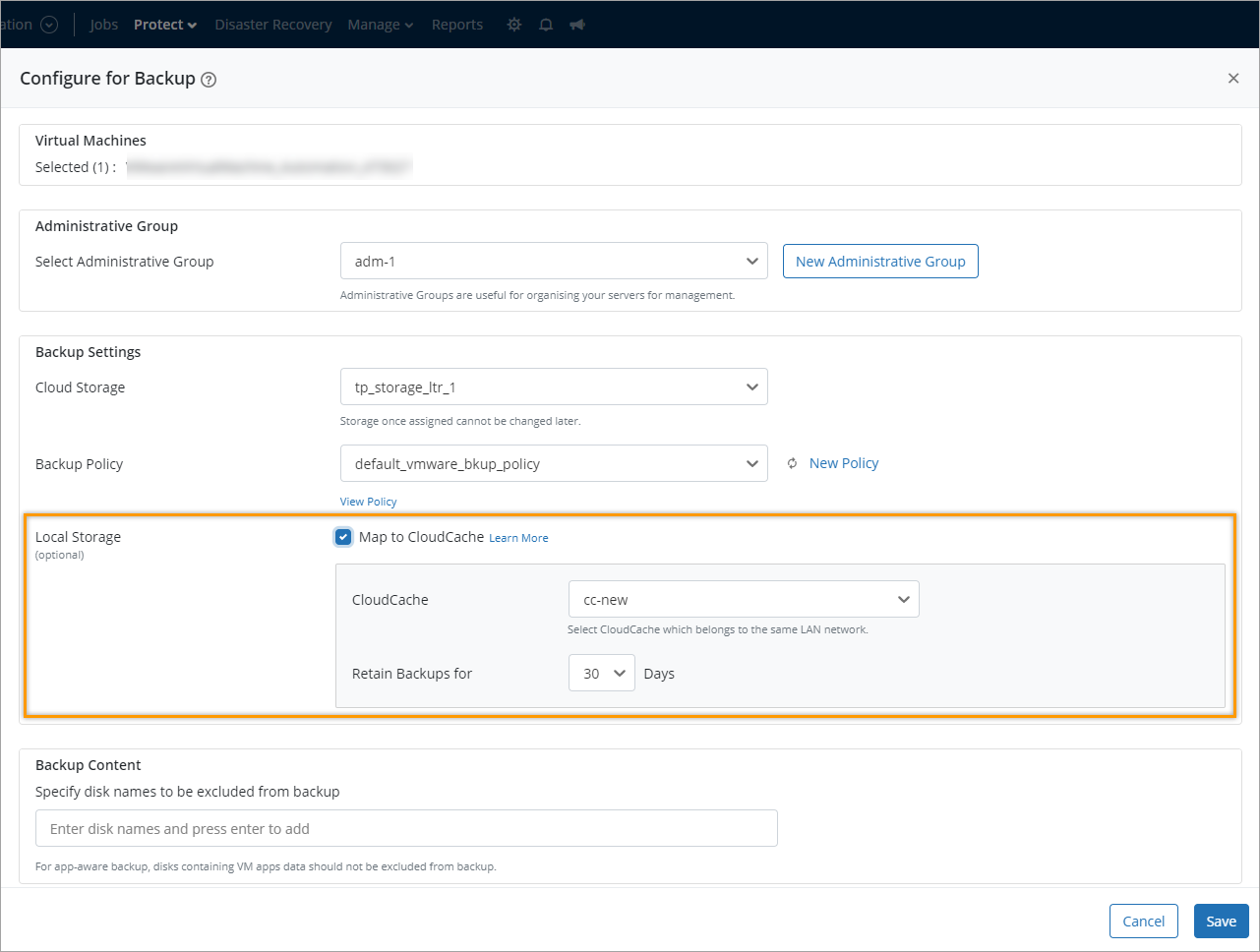
Customer action required: Phoenix CloudCache must be configured. For more information, see Configure Phoenix CloudCache.
UEFI support for DRaaS
Phoenix supports disaster recovery of virtual machines with Unified Extensible Firmware Interface (UEFI).
For more information, see DRaaS support matrix.
Customer action required: Upgrade Phoenix AWS proxy to version 4.9.1-101573 .
Expanded support for DRaaS
Phoenix DRaaS now supports the following:
-
CentOS: 7.6, 7.7, 7.8
-
Ubuntu: 18.04
For more information, see DRaaS support matrix.
Customer action required: None
Btrfs file system support for VMware file-level restore
You can now perform a file-level restore of Btrfs filesystem (Linux).
For more information, see Support matrix.
Customer action required: None
Introducing a new user experience for Cost Allocation
We're working relentlessly to enhance your product experience. So, we have redesigned the Cost Allocation page that has an intuitive user interface to let you accomplish tasks with ease.
For more information, see Cost Allocation.
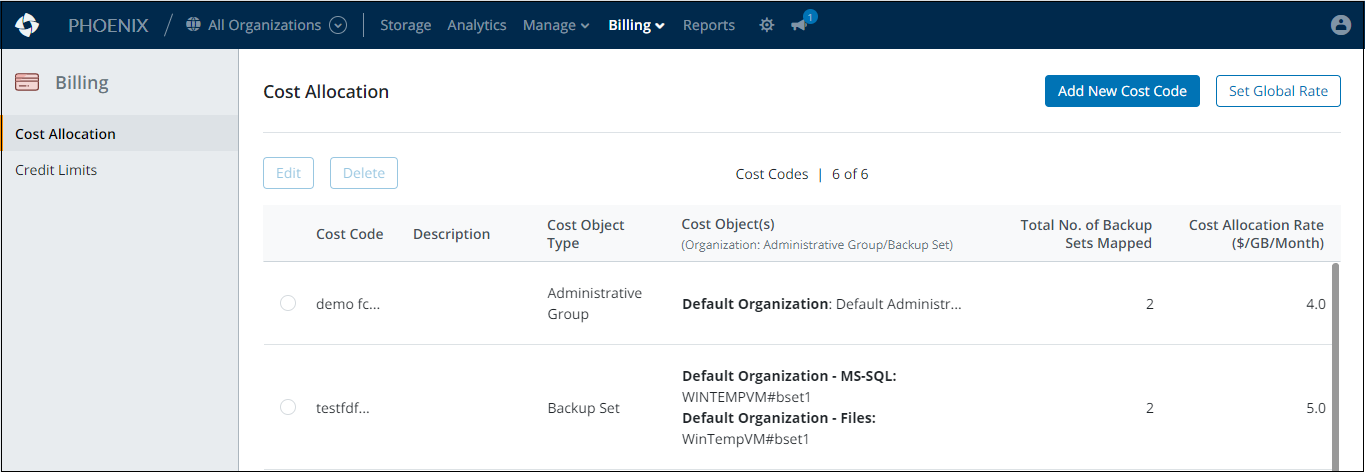
Enhanced UI for managing Administrative Groups
The user interface for managing Administrative Groups is revamped for easier operations.
For more information, see Manage administrative groups.
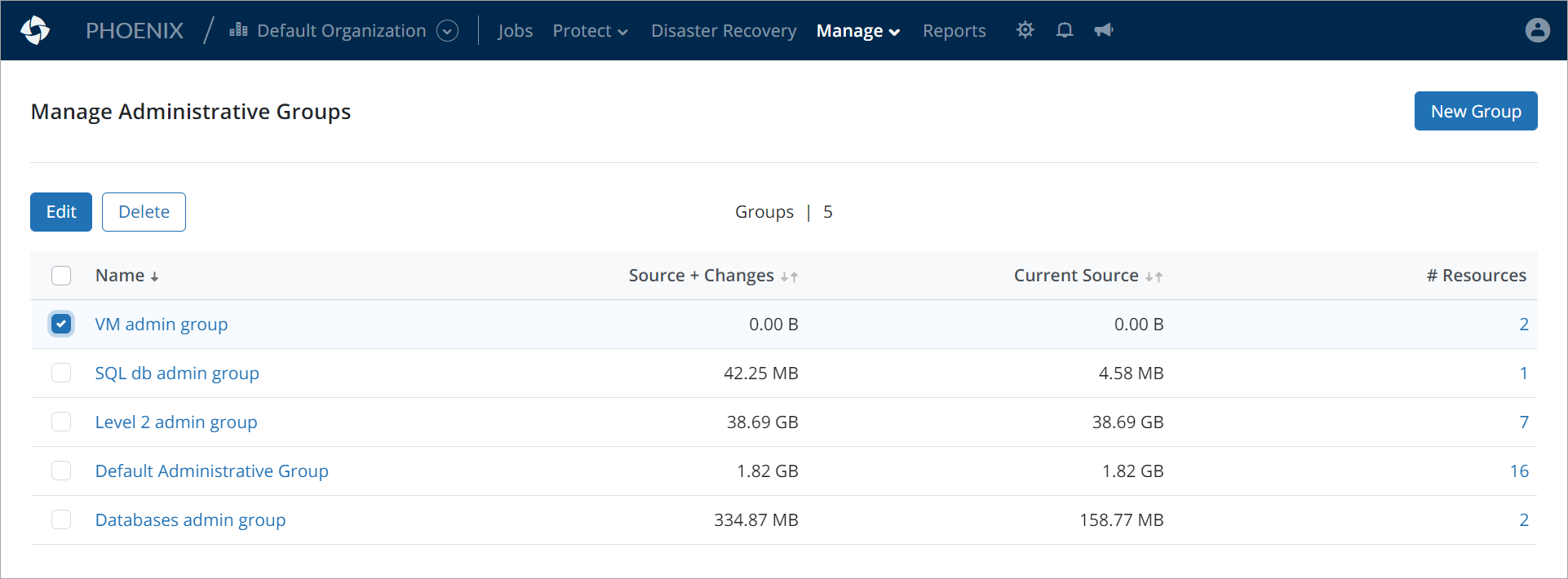
Customer action required: None
Enhanced UI for managing Activation Tokens
The user interface for managing Activation Tokens is revamped for easier operations.
For more information, see Manage activation token.

Customer action required: None
NAS API enhanced to return content rule information 
The List all content rules API is enhanced wherein, the NAS rule structure returns content rule information.
For more information, see List all content rules.
Customer action required: No action required.
Known Issues
| Issue | Description |
|
PHN-1873 |
Deleting a backup mount fails if a backup job (snapshot upload to the Phoenix Cloud) is in progress or has any pending ZFS snapshots to upload to the Phoenix Cloud. |
| PHN-1874 |
Re-registering a Phoenix Backup Store device fails. Workaround:
|
|
PHN-21387 |
The expired restore points are deleted from the Restore page, however, the count of Restore points displayed on the Phoenix Backup Store details page is not updated for the deleted Restore Points. |
|
PHN-23673 |
Creating or editing a backup set in NAS generates the error Issue: "Error while creating backupset(s). Error: Failed to configure backupset". This happens because there is another backup set on the NAS share with the same backup content. Resolution: Ensure that the content in this backup set does not overlap the content in other backup sets configured for the same NAS Share. |
Revision Information
| Platform | Revision | Public Cloud | Gov Cloud |
|---|---|---|---|
| Windows | 4.9.1-101583 |
|
|
| Linux | 4.9.1-101583 | ||
| VMware Backup Proxy | 4.9.1-102213 | ||
| Hyper-V FLR Proxy | Not applicable | ||
| Phoenix Backup Store | 4.9.1-102243 |
October 05, 2020
New Features
Federal Information Processing Standards Compliance
We are excited to announce that Phoenix is now a Federal Information Processing Standard (FIPS) 140-2 compliant data protection solution in the AWS GovCloud (US). FIPS includes publicly announced security standards developed by the US Federal Government for computer systems used by non-military government agencies and government contractors.
The FIPS Publication 140-2 is a US Government standard that defines minimum security requirements for cryptographic modules in systems/services as per Section 5131 of the Information Technology Management Reform Act of 1996. The FIPS 140-2 standard is published by the US National Institute of Standards and Technology (NIST) and outlines the requirements that federal agencies and departments must adhere to when using technology that uses cryptography for transmission and storage of their data.
The Cryptographic Module Validation Program (CMVP), is a joint effort of NIST and the Canadian Center for Cyber Security (CCCS). CMVP validates cryptographic modules to meet the requirements for the Cryptographic standard (FIPS 140-2) and related FIPS cryptography standards. The FIPS 140-2 security requirements cover 11 areas related to the design and implementation of cryptographic modules.
Government agencies and contractors that must adhere to the FIPS 140-2 cryptographic standard now have the ability to meet the technology requirements for running sensitive workloads in the Phoenix GovCloud.
Druva’s end-to-end FIPS support within GovCloud offers:
-
AWS GovCloud (US): An isolated AWS Region designed to allow US Government agencies and customers to move sensitive workloads to the cloud by addressing their specific regulatory and compliance requirements, the AWS GovCloud (US) framework adheres to the US International Traffic in Arms Regulations (ITAR) as well as the Federal Risk and Authorization Management Program (FedRAMPSM) requirements.
-
FIPS-Compliant Data Storage: Once within the GovCloud environment, unique block data is encrypted by algorithms using a FIPS-validated module and stored within the S3 object storage using the S3 FIPS-validated endpoint.
Customer action required: Ensure that the version of the Phoenix agent deployed in the GovCloud is upgraded to 4.7.7 or later.
Support for Oracle Linux 7.8 for files, folders, and NAS shares
Phoenix now supports the backup and restore of files and folders, and NAS shares on Oracle Linux 7.8. For more information, see Support matrix.
Customer action required: Upgrade the Phoenix agent to the latest revision.
Upcoming features
The following features are scheduled to get released on October 19, 2020:
Configure Phoenix CloudCache (local storage) when you configure virtual machine backups
Starting 19th October 2020, when you configure your virtual machines for backup, you can select local storage to store backups locally by mapping a Phoenix CloudCache.
- ► The option will be available when you create or edit an auto-configuration rule or manually configure or reconfigure virtual machines for backup. (Click to expand)
-
Auto configuration rules
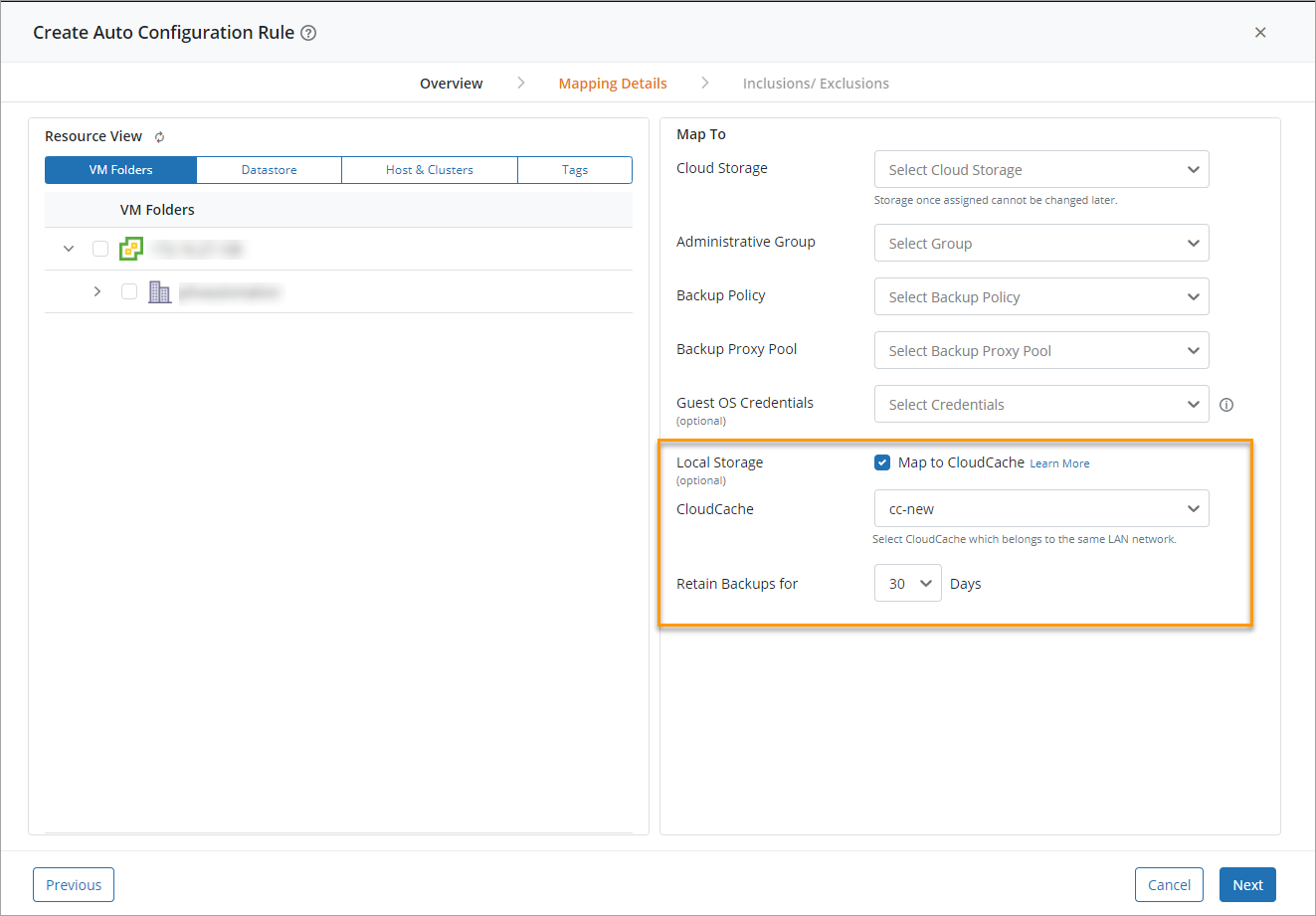
Manual configuration

Customer action required: Phoenix CloudCache must be configured. For more information, see Configure Phoenix CloudCache.
Restore individual database for application-aware backups
Starting 19th October 2020, you can restore databases from application-aware backups without requiring to restore the entire virtual machine. You can restore the database to its original location or an alternate location. You can also restore just the database files from a snapshot.
Also, when you perform a full VM restore, of MS SQL virtual machines (application-aware), the restored databases will be application-consistent.
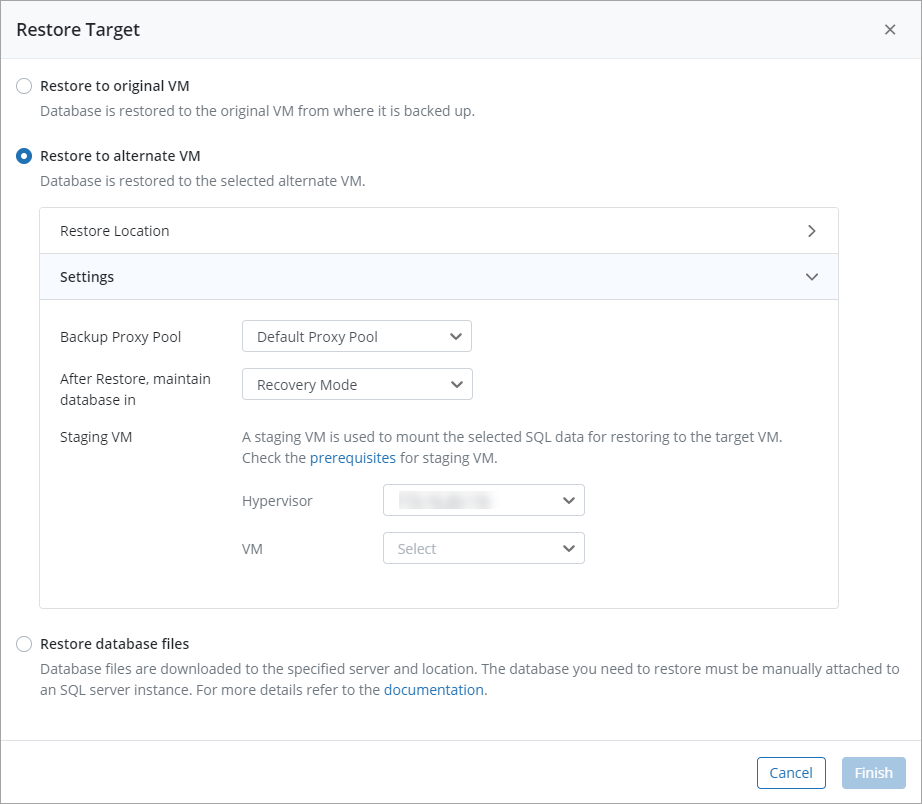
Note: This enhancement is only applicable to VMware on-premises as the NFS datastore is not supported by VMware cloud.
Customer action required: Deploy a fresh additional backup proxy and provision a Windows staging virtual machine.
Planning for a Windows staging virtual machine for application-aware database restores
When the source virtual machine (MS SQL) is backed up, Phoenix takes VSS snapshots of the drives where the database files reside and then backs up the entire disk attached to the source virtual machine. These disks (vmdk files) are then uploaded to Phoenix Cloud.
Now while restoring, because VSS is a proprietary feature of Windows, a Windows virtual machine (staging) is required to read the disks. A staging virtual machine is used to mount the selected vmdk files to the staging virtual machine from where Phoenix reads the SQL data for restoring to the target virtual machine.
- ► The Windows staging virtual machine should meet the following criteria (Click to expand):
-
- The staging virtual machine must be in the same vCenter or ESXi (if standalone) as the target virtual machine.
- The staging virtual machine must not be configured for backup in Phoenix.
- The staging virtual machine must be a Windows server at version same or higher than the source virtual machine.
- Windows Server virtual machines must be used for staging and not client virtual machines. When the disk is attached to Windows client virtual the VSS snapshots might get deleted in some cases. Hence it is not advisable to use Windows Client virtual machine for staging location
- VMware tools must be running.
- Required credentials must be assigned.
Diskpart is used to bring disks online. To run diskpart, the virtual machine must be logged in to your local Administrators group, or a group with similar permissions. For more information, see https://docs.microsoft.com/en-us/windows-server/administration/windows-commands/diskpart#syntax
Note: The virtual machine must be powered on when credentials are being assigned. - Disk UUID on must be enabled. For more information, see https://kb.vmware.com/s/article/50121797
- The staging virtual machine must not be cloned from the source VM (whose backup is done).
- If there are any VSS snapshots on the staging virtual machine then remove them before running the job.
- It recommended that the staging virtual machine should not have GPT disks as they may cause problems with attaching and reading data from the new disks.
- The target and staging virtual machine must not be the same.
- Ensure that the limit of attaching the NFS datastore is not exhausted. Phoenix attaches a NFS datastore to the parent ESX host where the staging virtual machine resides. Thus it is recommended you review best practices for running VMware vsphere on NFS to understand the limitations and tunable configuration for mounting NFS volumes on an ESXi host.
- You need to open two ports between range 65535 to 49125 for communication with staging VM and Target VM (guest OS). You must update the Phoenix.cfg file if you want to use the ports from the above range. For example, RESTORE_PORT_RANGE = [58142, 58141]. For more information, see Phoenix agent configuration details. If these ports are not opened, ephemeral ports between the range 65535-49125 will be used. Ensure that the last 3-4 ports in this range are open.
- Add an exception for antivirus scans for the following path on the staging and target virtual machine:
%ProgramData%\Phoenix\VMWARE\
Revision Information
| Platform | Revision | Public Cloud | Gov Cloud |
|---|---|---|---|
| Windows | 4.9.0-100101 |
Not applicable |
|
| Linux | 4.9.0-100101 | ||
| VMware Backup Proxy | 4.9.0-100468 | ||
| Hyper-V FLR Proxy | 4.9.0-100101 | ||
| Phoenix Backup Store | 4.9.0-100101 |
Note: Refer to the "Revision information" table to know if the feature is available for Public Cloud/ GovCloud or both
September 21, 2020
Enhancements
New backup job type filters in MS-SQL
You can now filter MS-SQL server jobs to see all Full, Differential, and Transaction Log SQL backups. You can also use the All Backups filter to view all your MS-SQL backups.
For more information, see View jobs page and Jobs Filters.
Customer action required: No action required.
Get visibility in your credit term
Phoenix now gives you an insight into the cogent lifecycle of credit utilization during the contract term. Phoenix simplifies the credit management process by:
- Displaying the credit term along with the credit balance on the Phoenix Management Console.
- Projecting the number of credits that may lapse or rollover at the end of the term.
- Determining the end date of the term based on the credit consumption pattern.
- Sending alerts periodically to notify administrators of the number of excess credits that may lapse at the end of the term and the number of credits expected to fall short in the current term.
For more information, see Credit term.
Note: Customers who have onboarded with the new contract type can view the credit term on the Dashboard page, the Analytics page, and on the My Accounts page. However, the credit term doesn't apply to customers who are still in the non-term contract.
Customer action required: No action required.
VMWare API enhanced to return backup proxy pool information
The List all backup proxies API is enhanced wherein, the backup proxy pool structure returns backup proxy pool name and time zone information.
For more information, see List all backup proxies.
Customer action required: No action required.
Configured virtual machine is disabled for backup after it is deleted
When a virtual machine configured for backup is deleted from the VMware environment, the first backup job after the virtual machine deletion fails. However, the virtual machine is disabled from backup to avoid subsequent job failures. The virtual machine that is disabled for backup will be still available for restore.
For information see, Delete a virtual machine configured for backup.
Customer action required: No action required.
Druva certification for VMware Cloud
Regardless of where customers run their VMware infrastructure, their data is comprehensively protected and always available with Druva Cloud Platform.
-
Druva is now certified for backup and disaster recovery of VMware Cloud on Dell EMC.
-
Druva is also certified with VMware Cloud on AWS SDDC 1.12. Druva is certified with every new version of VMware Cloud on AWS that is released quarterly.
Customer action required: No action required.
Revision Information
| Platform | Revision | Public Cloud | Gov Cloud |
|---|---|---|---|
| Windows | 4.9.0-100101 |
|
Not applicable |
| Linux | 4.9.0-100101 | ||
| VMware Backup Proxy | 4.9.0-100468 | ||
| Hyper-V FLR Proxy | 4.9.0-100101 | ||
| Phoenix Backup Store | 4.9.0-100101 |
August 17, 2020
New Features
Hyper-V APIs
Druva now offers APIs that you can use to organically interact with Phoenix for Hyper-V workloads that Phoenix protects. Integrate tools and applications with Phoenix using the APIs to have a more customizable experience for reporting, analytics, alerts, and insight into the performances of Hyper-V hosts and virtual machines that Druva Phoenix protects.
For more information, see API reference documentation on the Druva developer portal.
Customer action required: No action required.
NAS share auto-discovery
Adding NAS shares just got easier! Phoenix now discovers NFS and SMB shares on a NAS device automatically as soon as you add the device in Phoenix. You can also run a share auto-discovery on-demand.
For more information, see Add a NAS share
Customer action required: Upgrade the NAS proxy to version 4.8.16-98358.
Support for Microsoft SQL Server 2019 for application-aware backup and restore
Druva Phoenix now backs up databases on Microsoft SQL Server 2019 inside a virtual machine using the Microsoft VSS and SQL Writer service.
Phoenix requires virtual machine credentials to perform application-aware backups.
Customer action required: Upgrade to the latest version (4.8.16-98404) of the Phoenix agent.
Enhancements
Introducing a new user experience for NAS
The newly redesigned NAS page in Phoenix has an intuitive user interface that lets you accomplish critical tasks with ease. Some of the key highlights of the new user interface are:
New Add NAS Proxy page
The new Add NAS Proxy page allows you to check prerequisites, download, install, and activate the NAS proxy from one single place.
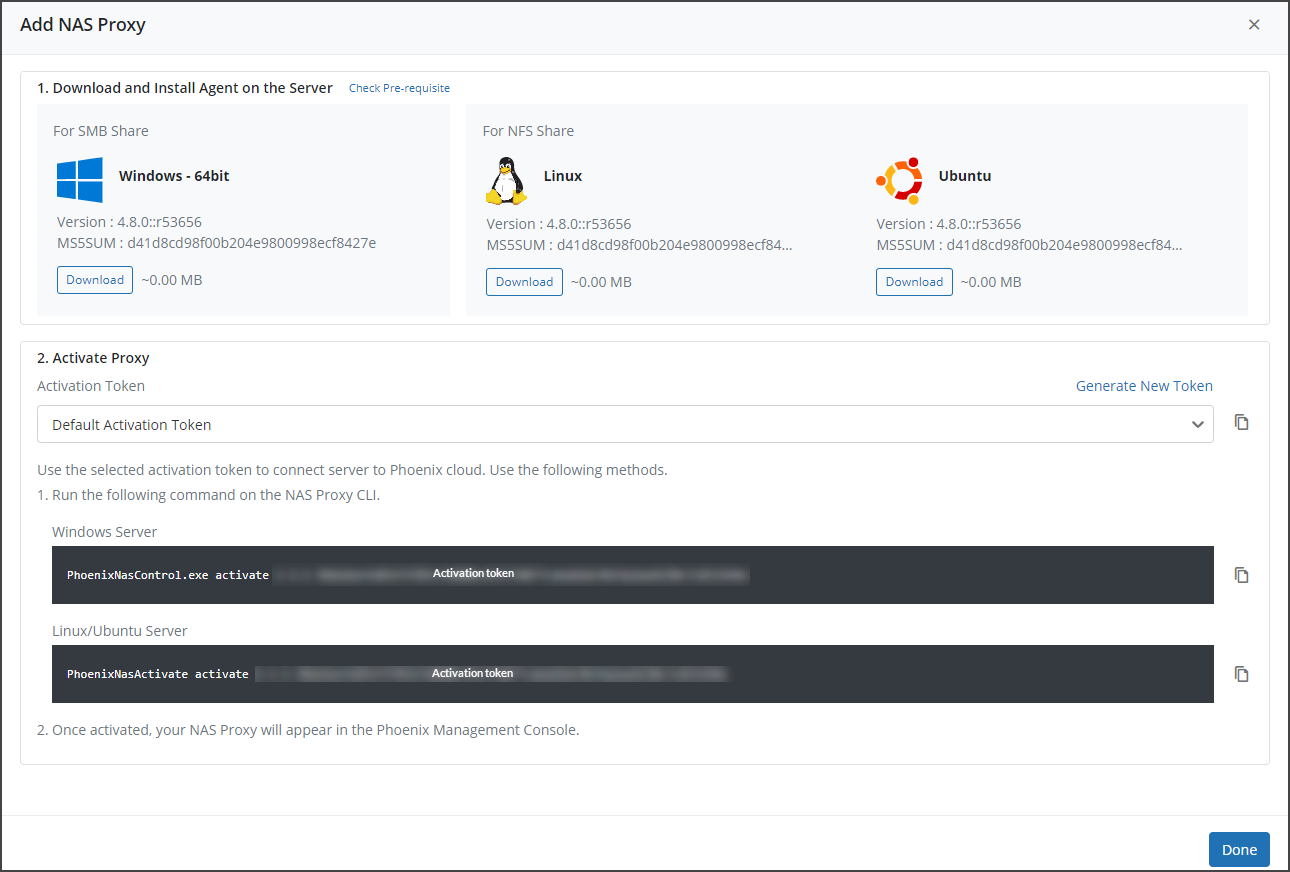
New Add Device page
The new Add Device page allows you to configure your NAS device and map it to registered NAS proxies. Share auto-discovery discovers NFS and SMB shares. If you select the Use device credentials for auto-discovered shares option, Phoenix assigns device credentials to auto-discovered SMB shares.

New Create Backup Set page for NAS shares
The new Create Backup Set page allows you to configure everything that you need to create a backup set for a NAS share from one single place.

New NAS share details page
The redesigned NAS share details page lets you see all the configured backup sets for the NAS share at a glance. You can view more details about the configured backup sets, add new backup sets, or restore data from this page itself.

A new Restore Files page
The new Restore Files page gives you a snapshot viewer where you can select the type of snapshot and the restore point from which you want to restore data. You can search for the files to be restored or browse the folder hierarchy for them. You can also restore files across multiple folders or directories.
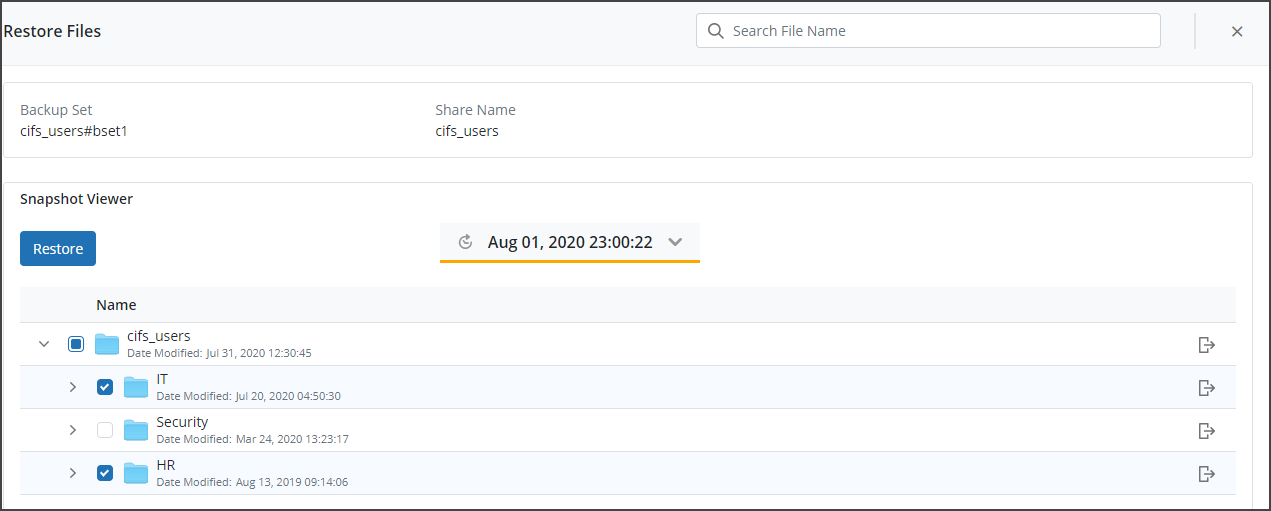
A new Jobs page for NAS
A new Jobs screen lets you see all your NAS jobs within the NAS page. You can also see the job details and logs.
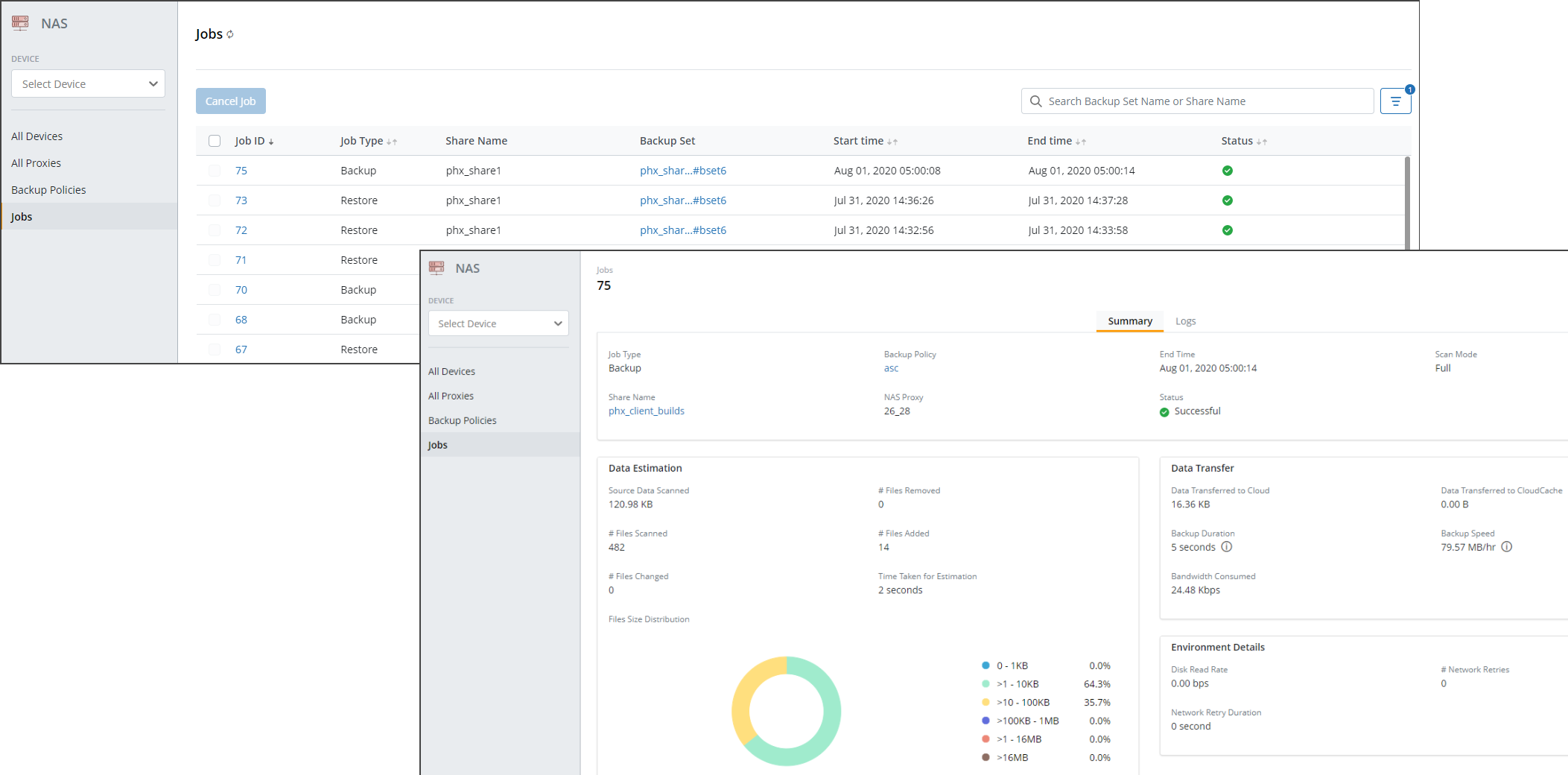
Integration with the Credential Store
The NAS workload now integrates with the credential store. Credentials are required to protect SMB shares. NFS shares do not need credentials.The Credential Store stores share-specific credentials that can be reused by other NAS shares on the device. The Credential Store also stores NAS device credentials. The credentials are validated while adding a NAS device mapped to a Windows proxy. The credentials updated in the Credential Store apply to all shares that use those credentials.
Backup performance improvement for small file backups in FS and NAS
Small file backups in File Server and NAS are now 15% faster over low latency networks and up to 52% faster over high latency networks.
For more information, see:
Customer action required: No action required.
Faster NAS backups
Incremental NAS backups are now up to 3x faster for data sets with low change rates.
Customer action required: Upgrade the NAS proxy to version 4.8.16-98358.
Introducing a new user experience for VMware
The Phoenix user interface for VMware workload is redesigned to help you perform critical tasks with ease. Key workflows such as deploying backup proxy, configuring VMs for backup, and restoring data are simplified. Following are some of the key enhancements:
Centralized Backup Proxy management
A common page to deploy additional backup proxies, create a proxy pool, and upgrade all backup proxies at one time.

Configure your virtual machines for backup with ease
Dedicated pages for manual and auto-configuration for virtual machines.


Centralized virtual machine management
A common page to perform all the tasks related to managing configured virtual machines.

Click on a configured virtual machine to view its configuration summary and backed up snapshots details.

Simplified restore experience
Intuitive restore workflows for virtual machines (non-application aware) and Microsoft SQL Server (application-aware). Also, now you have a tree view to select your data across folders and restore.
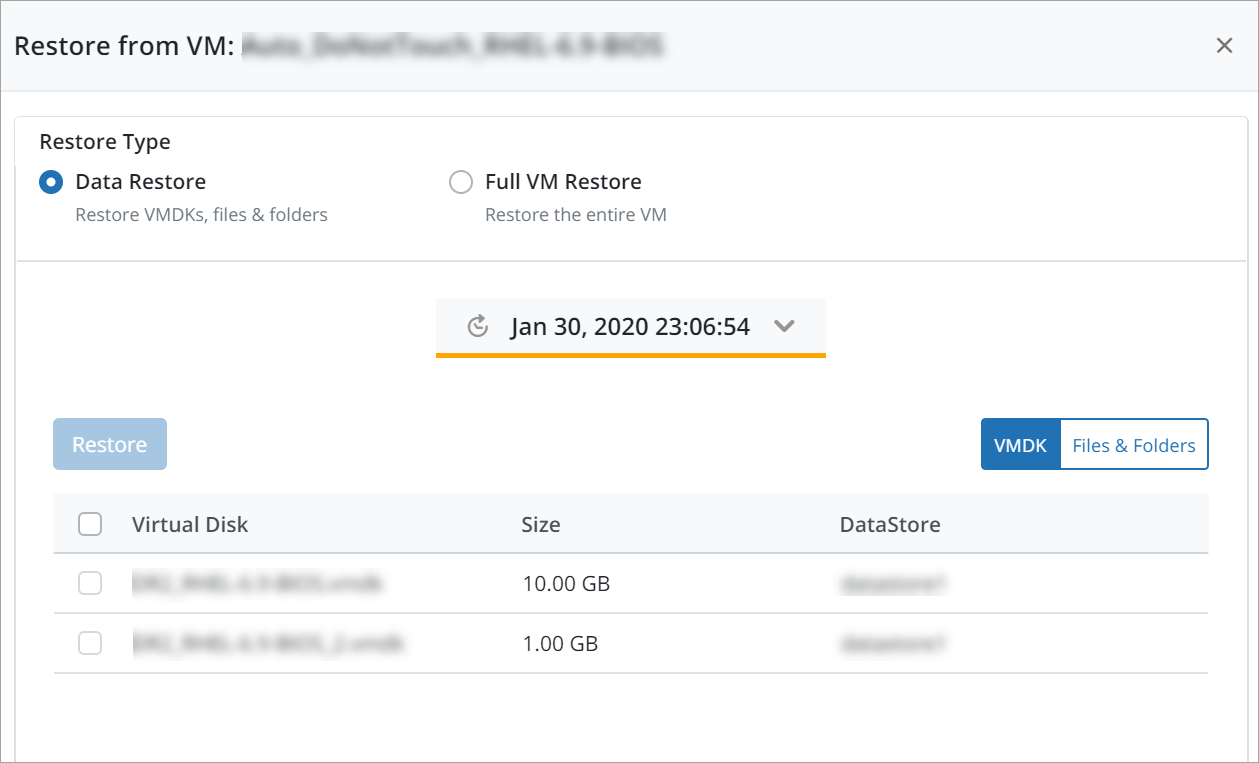
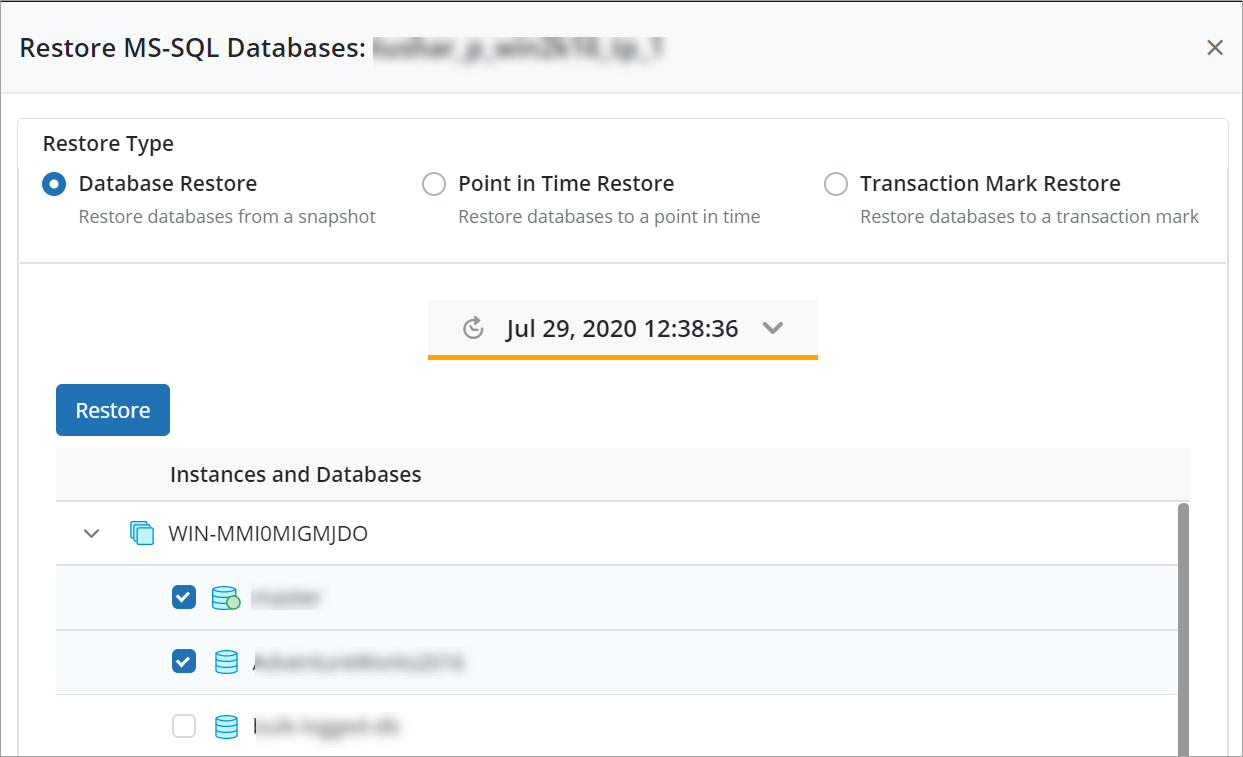
For more information, see Backup and Restore VMware Virtual Machines.
Customer action required: No action required.
Revision Information
| Platform | Revision | Public Cloud | Gov Cloud |
|---|---|---|---|
| Windows | 4.8.16-98358 |
|
|
| Linux | 4.8.16-98358 | ||
| VMware Backup Proxy | 4.8.16-98404 | ||
| Hyper-V FLR Proxy | 4.8.16-98236 | ||
| Phoenix Backup Store | Not applicable |
Upcoming features on August 17, 2020
We are glad to announce the following enhancements scheduled for August 17, 2020.
Simplified user experience for NAS
The Phoenix user interface for NAS workload is redesigned to help you perform critical tasks with ease. Key workflows such as adding a NAS device, adding a NAS proxy, creating backup sets are simplified.
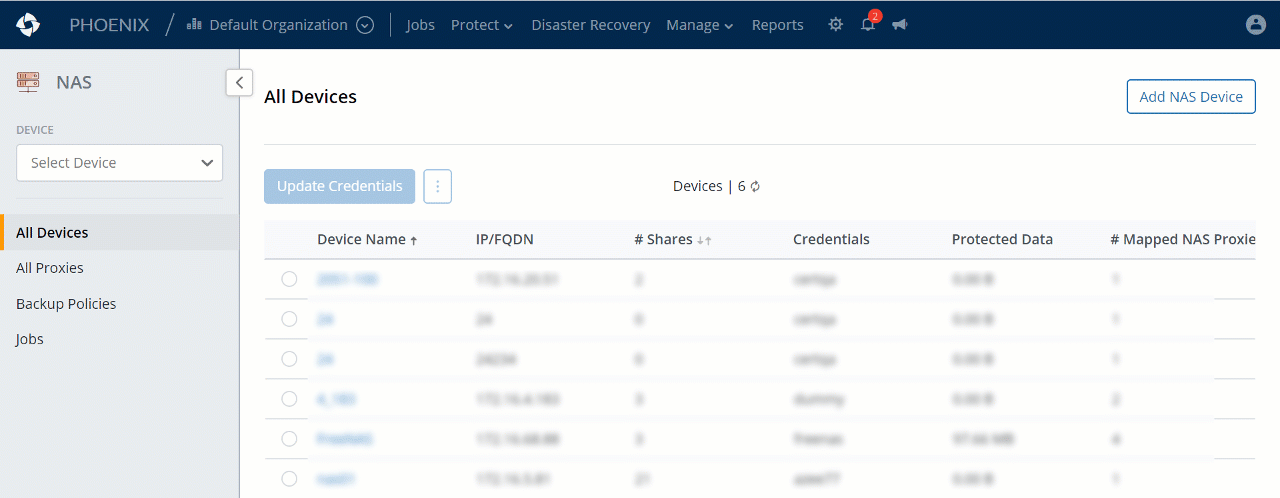
Also, when you have a large number of shares, you need not add them manually. Phoenix automatically discovers shares on the NAS device as soon as you add it. You will also be able to run share auto-discovery on demand.

Customer action required: To use the auto-discovery feature, upgrade the NAS proxy to the latest version.
Simplified user experience for VMware
The Phoenix user interface for VMware workload is redesigned to help you perform critical tasks with ease. Key workflows such as deploying backup proxy, configuring VMs for backup, and restoring data are simplified.

July 20, 2020
New Features
Get visibility in your credit term
Phoenix now gives you an insight into the cogent lifecycle of credit utilization during the contract term. Phoenix simplifies the credit management process by displaying the credit term (contract period) along with the credit balance on the Phoenix Management Console.
For more information, see Credit term.
Note: Customers who have onboarded with the new contract type can view the credit term on the Dashboard page, the Analytics page, and on the My Accounts page. However, the credit term doesn't apply to customers who are still in the non-term contract.
Customer action required: No action required.
Support for Windows Server 2019 Hyper-V virtual machine hosts
Phoenix can now back up and restore virtual machines created and managed by Hyper-V on Windows Server 2019. For more information on the certified versions, see System Requirements for Hyper-V.
Customer action required: Install the latest Phoenix agent on the Hyper-V host on Windows Server 2019.
Backup and restore support for Symlinks on Windows File Server and NAS Shares
Druva Phoenix now lets you backup and restore the following link file system objects on Windows File Server and NAS Shares. This feature was previously supported only on Linux.
-
Symlinks are symbolic link file-system objects which reference a physical file or folder located elsewhere. These can be either absolute or relative links.
-
Hard Links are file system representations of a file by which more than one path references a single file in the same volume.
Note: Phoenix backs up only the link files and not the file or directory they point to.
Customer action required: Upgrade to the latest version of Phoenix agent.
Revamped Deployment Experience for VMware
You can now register your VMware setup with Phoenix in a jiffy using the Druva Proxy Deployer utility. You no longer need to deploy the OVA templates manually. Simply download the Druva Proxy Deployer utility from the Phoenix Management Console on your local system and the utility will guide you through the backup proxy deployment process.
Watch the video for the new simplified deployment experience.
For more information, see Deploy the first backup proxy and register the VMware setup.
Customer action required: No action required.
Support for VMware vCenter version 7.0 and standalone ESXi host version 7.0
You can now protect vCenter version 7.0 and standalone ESXi host version 7.0.
Customer action required: If you are using vSphere version 7.0 or planning to upgrade, you need to redeploy the backup proxies from the Phoenix Management Console. For more information see, Deploy additional backup proxies.
Fixed issue
The format of the startTime and endTime parameters for queued and running jobs is now fixed and in line with job statuses in the Jobs APIs.
Revision Information
| Platform | Revision | Public Cloud | Gov Cloud |
|---|---|---|---|
| Windows | 4.8.15-96907 |
|
|
| Linux | 4.8.15-96907 | ||
| VMware Backup Proxy | 4.8.15-96907 | ||
| Hyper-V FLR Proxy | 4.8.15-96907 | ||
| Phoenix Backup Store | 4.8.15-97113 |
June 15, 2020
This cloud update has minor bug fixes.
Revision Information
| Platform | Revision | Public Cloud | Gov Cloud |
|---|---|---|---|
| Windows | 4.8.14-94748 |
|
|
| Linux | 4.8.14-94748 | ||
| VMware Backup Proxy | 4.8.14-94733 | ||
| Hyper-V FLR Proxy | Not applicable | ||
| Phoenix Backup Store | Not applicable |
June 01, 2020
New Feature
Ability to back up Oracle data files and archived logs separately
Phoenix now provides scripts to back up data files and the archived log files of Oracle standalone instances, separately.
For more information, see:
- Configure the Phoenix Backup Store and RMAN hosts to backup databases
- Template shell scripts for Linux and Solaris RMAN hosts
Customer action required:
- Upgrade the Phoenix agent to the version 4.8.14-94040. You can download the latest agent from the Downloads page.
-
Configure the new oracle_rman_data_backup.sh and oracle_rman_archivelog_backup.sh scripts (instead of the existing oracle_rman_backup.sh script) to back up data files and the archived log files.
Fixed issues
Phoenix backups failed on the non-VSS partitions such as FAT, FAT 32, and exFAT.
Revision Information
| Platform | Revision | Public Cloud | Gov Cloud |
|---|---|---|---|
| Windows | 4.8.14-93903 |
|
|
| Linux | 4.8.14-93903 | ||
| VMware Backup Proxy | 4.8.14-93903 | ||
| Hyper-V FLR Proxy | Not applicable | ||
| Phoenix Backup Store | 4.8.14-94040 |
May 18, 2020
New Feature
Automated additional backup proxy deployment for VMware
You can now deploy multiple backup proxies in a single workflow from the Phoenix Management Console. The proxy deployment process is simplified in a way that:
- The OVFs templates are deployed automatically in the backend; you don’t need to deploy them manually.
- Backup proxies are deployed in a data center and you can specify the backup proxy pool in which you want to deploy the backup proxies.
- You can provide a range of IP addresses to the number of proxies.
- You can assign two NIC cards to the backup proxy.
- The Backup proxy deployment job type is introduced to execute the deployment.
For more information, see Deploy additional backup proxies.
The following GIF image demonstrates the enhanced user interface:
Customer action required: Upgrade the backup proxy to version 4.8.14-93097. You can download the VMware backup proxy from the Downloads page.
Backup proxy pool association with a data center for VMware
With this release, the backup pools are associated with a data center. This association helps you efficiently load balance your geographically distributed data centers and associated clusters.
For more information, see Backup proxy load balancing.
The following GIF image illustrates the association:

The following GIF image demonstrates the enhanced user interface:
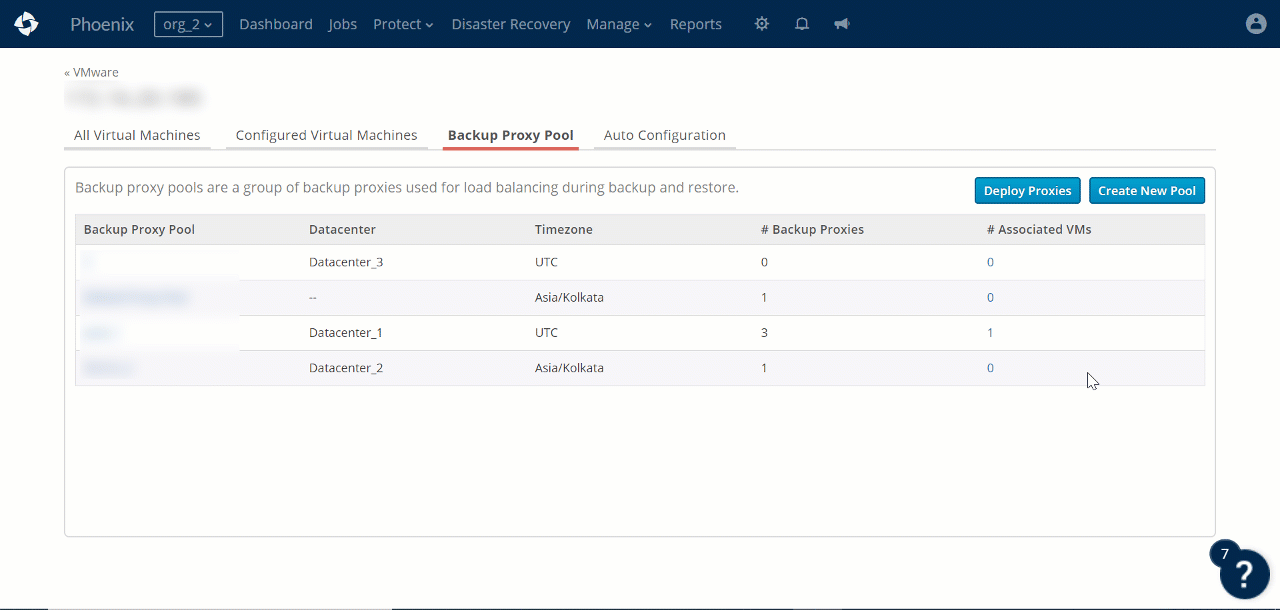
Customer action required: Upgrade the backup proxy to version 4.8.14-93097. You can download the VMware backup proxy from the Downloads page.
Enhancements
Support for additional CIFS and NFS share attributes
Phoenix now supports the backup and restore of additional file attributes for CIFS/SMB, Linux and NFS shares. The supported attributes are:
CIFS/SMB shares
-
Owner
-
ctime
-
Primary group
-
SACL
-
DACL
Linux and NFS shares
-
Owner
-
Mtime
For more information, see:
Customer action required: Upgrade the Phoenix agent to the latest version, 4.8.14-93097.
Enhancements to Jobs APIs
Druva Phoenix now provides enhanced Jobs APIs to help API users gain more insight into the job details and to easily integrate APIs with the BI tools.
The API enhancements include:
- Provision of the error codes and error messages for the Jobs APIs
- Standardization of units across the Jobs API parameters. The Jobs parameters are now specified in additional units. The following units are introduced for the Jobs parameters:
- Second: Used for parameters that specify the duration.
- Bytes: Used for parameters that specify data size.
- Kilobytes per second: Used for parameters that specify data speed and bandwidth.
To know more about Jobs APIs, see https://developer.druva.com/docs.
Revision Information
| Platform | Revision | Public Cloud | Gov Cloud |
|---|---|---|---|
| Windows | 4.8.14-93097 |
|
|
| Linux | Not applicable | ||
| VMware Backup Proxy | 4.8.14-93097 | ||
| Hyper-V FLR Proxy | 4.8.14-93097 | ||
| Phoenix Backup Store | Not applicable |
May 7, 2020
New Feature
Druva Phoenix APIs available for GovCloud Customers
Druva is excited to announce the release of APIs for Phoenix GovCloud customers, which are now available on developer.druva.com. GovCloud customers can use these APIs to create reports and get insights into the jobs and their data. These APIs are authenticated using OAuth 2.0 access token, which is the most secure and popular authentication mechanism for APIs.
The following APIs have been published with this release:
-
AuditTrail
-
CloudCache
-
File Server
-
Alerts
-
NAS
-
Organization
-
Storage
-
SQL Server
-
VMware
Customer action required: No action required.
Enhancement
Jobs APIs to show the latest data
We have made some design changes and improvements to show real-time data for Jobs APIs.
To know more about Jobs APIs, see https://developer.druva.com/docs
April 20, 2020
Enhancements
Enhancements to search and restore in file server and NAS
Druva Phoenix now gives you the option to restore the latest version, all versions, and specific versions of file server and NAS files selected through backup set search. You can now select single or multiple files from the search results for restore. Depending upon the selections, some or all of these options are available.
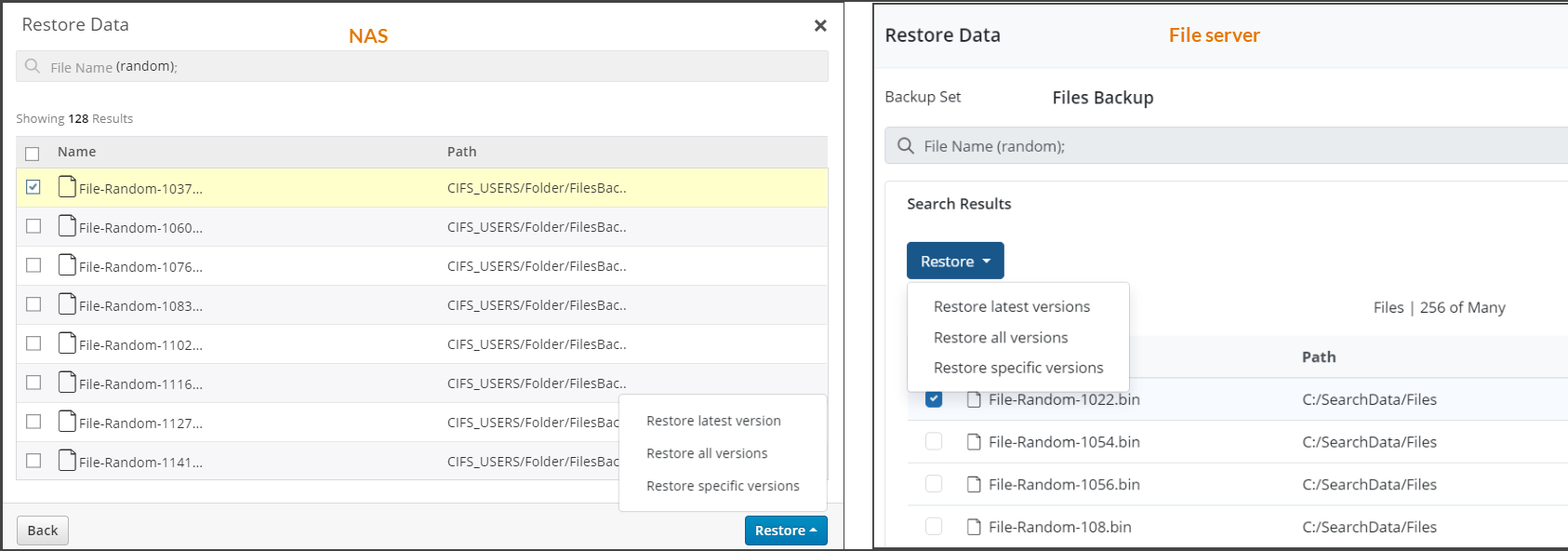
For more information, see:
Customer action required: No customer action is required.
Download the Phoenix agent within the app
You can now select the operating system of the file server and download the respective Phoenix agent from the Phoenix Management Console itself while registering the server.

For more information, see:
Customer action required: Update the Phoenix agent to the latest version 4.8.13-91382.
Complete credential store integration with file and SQL servers
Druva Phoenix allows you to assign credentials to Windows Servers and MS-SQL Servers. When you assign a credential to a server in the Phoenix Management Console, Phoenix automatically assigns it to the Phoenix service on the Windows file server, and this credential persists through agent upgrades. If you update an old credential in the credential store, it automatically updates that credential for all servers which were using that credential. The Phoenix agent service running on those servers is assigned the updated credentials as well.
You can manage these credentials from the Registered Servers screen under the Windows/Linux servers page. The Credentials column displays the credentials assigned to each server and their validation status. The Manage Credentials functionality allows you to:
-
Create a new credential
-
Assign a credential to a server
-
Unassign a credential from a server
Customer action required: Update the Phoenix agent to the latest version 4.8.13-91382.
Role-based access enhancements
With this release the following rights are customizable when you create custom roles:
-
Register and Re-register server or proxy
-
View reports and alerts
-
Manage email schedules and subscriptions
Also, a new customizable right is added for DRaaS:
-
Delete AWS Proxies
For more information see, Manage administrator roles.
Customer action required: No customer action is required.
Cost Allocation Report and Credit Limits now account for LTR savings
With this release, the Cost Allocation Report and Credit Limits will account for LTR savings.
The Cost Allocation Report gives you granular details of the credits consumed and accounts for LTR credit savings over the month. This report shows historical data for 12 months.
To know more, see:
Customer action required: No action required.
Revision Information
The following table lists the versions of the agents released:
| Platform | Revision | Public Cloud | Gov Cloud |
|---|---|---|---|
| Windows | 4.8.13-91382 |
|
|
| Linux | 4.8.13-91382 | ||
| VMware Backup Proxy | 4.8.13-91481 | ||
| Hyper-V FLR Proxy | 4.8.13-91382 | ||
| Phoenix Backup Store | NA |
April 6, 2020
New Features
Realize Storage Insights and Recommendations
Druva is excited to introduce Realize Storage Insights and Recommendations services that help customers optimize their storage utilization costs. Built on top of Druva Phoenix - these insights are available for File Server and NAS data sources.
Realize Storage Insights: Primarily designed to provide customers visibility into their data under protection, Storage Insights enables customers to gain insights into non-critical business data and take the required actions to exclude it from backup and thus, optimize their storage costs. It enables administrators to:
-
Get unprecedented visibility into the storage and the type of data under protection
-
View data growth and storage consumption trends
-
Plan and manage the storage costs required to protect the essential data over the period
To learn more, see Realize Storage Insights.
Recommendations: A smart service designed to identify and proactively inform administrators about the storage utilization costs on the non-business critical data under protection and recommend necessary action to exclude it from backup and save costs. It enables administrators to:
-
Effectively monitor and take real-time actions to stop non-critical business data from being backed up
-
Analyze the type of data under protection
-
Save storage costs by improving the content rules and backup policies
To learn more, see Recommendations.
Customer action required: No user action is required.
Realize Storage Insights and Recommendations services are available at no additional cost for Phoenix customers with Elite and Enterprise License and enabled by default for File Server and NAS data sources that are under protection.
Support for SQL Server 2019
With this release, Druva is excited to announce support for Microsoft SQL Server 2019 with Druva Phoenix. You can now protect SQL Server 2019 databases with Phoenix.
Customer action required: Upgrade to the Phoenix agent version 4.8.12-90434, if already upgraded to SQL Server 2019
Credit consumption report
Knowing and understanding your credit consumption with Druva is an important step towards using our products efficiently. With this thought, we’ve introduced a new report called the Credit Consumption Report that you can view, download, and subscribe to on a monthly basis.
The report’s duration is set as the last 12 months by default and it shows details such as:
-
The month
-
Total credits consumed
-
Credits consumed by storage
-
Credits consumed due to early data deletion (Applicable for LTR customers)
-
LTR savings (Applicable for LTR customers)
For more information, see Credit Consumption Report.
Customer action required: No user action required
Enhancements
Introducing a new user experience for file servers
The newly redesigned Windows/Linux Servers page in Phoenix gives you a modern user interface that is intuitive and lets you accomplish key tasks in fewer clicks. Some of the key highlights of the new user interface are:
New Configure Backup for Selected Servers page
The new Configure Backup for Selected Servers page allows you to configure everything that you need to create a file backup set in one single place.
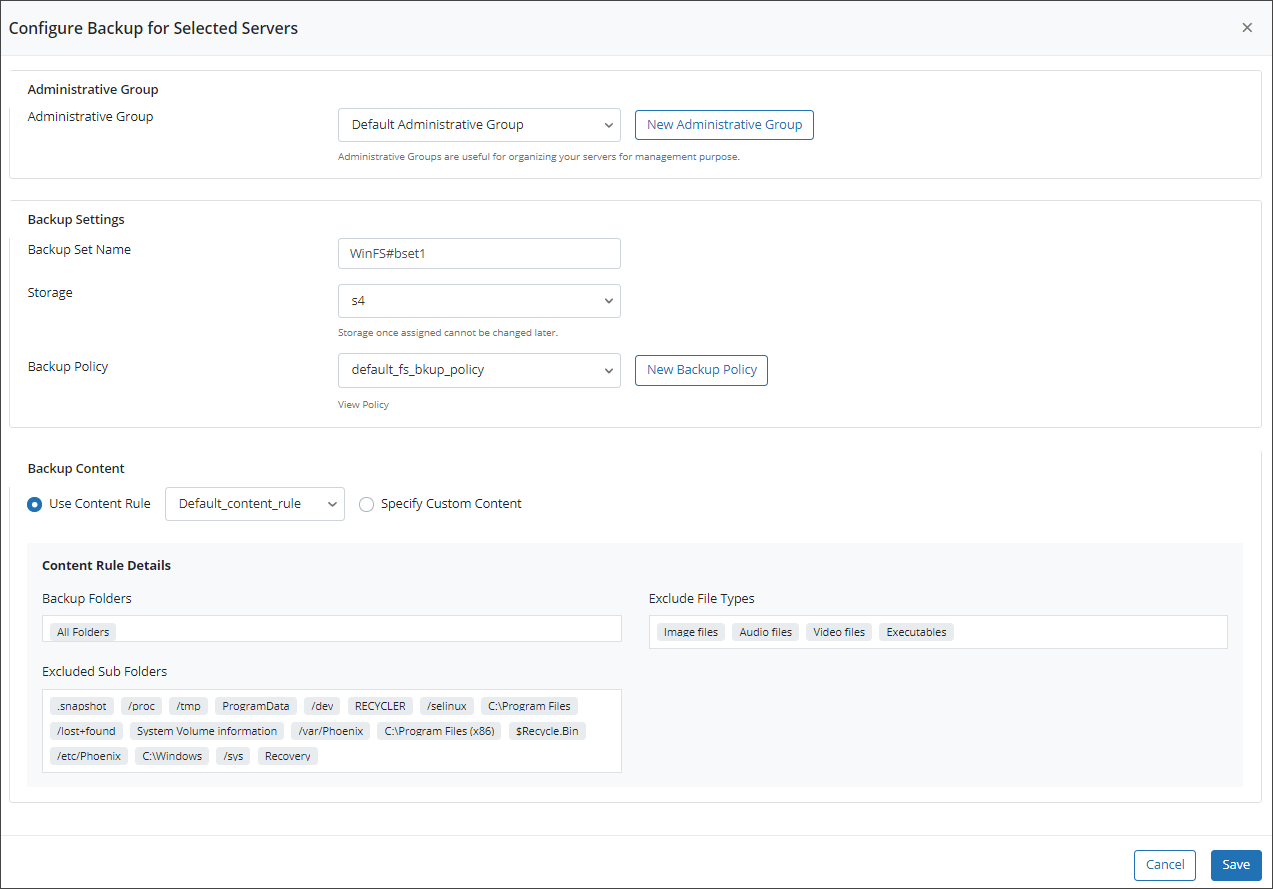
A new server details page
The redesigned server details page lets you see all the configured backup sets for the server at a glance. You can view more details about the configured backup sets, create new backup sets or restore data from this page itself.
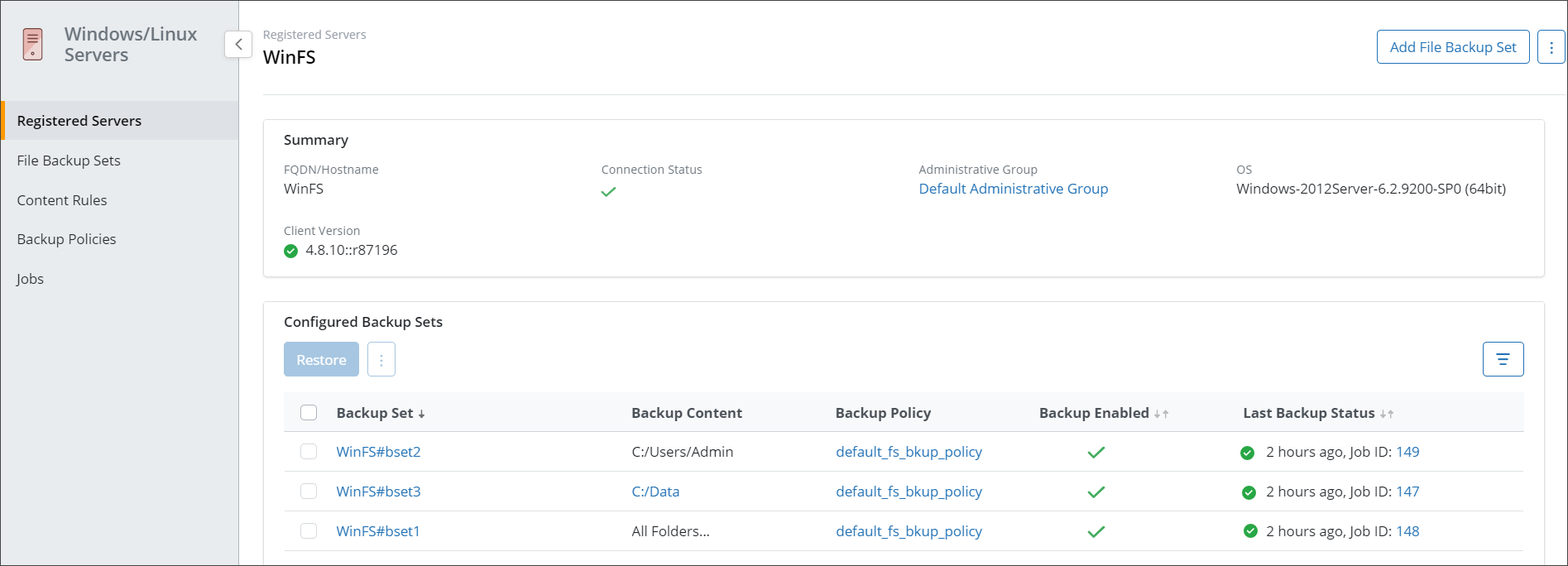
A new Restore data page
The new restore data page gives you a snapshot viewer where you can select the type of snapshot and the restore point from which you want to restore data. You can search for files to be restored or browse the folder hierarchy for them. You can also restore files across multiple folders or directories.

A new jobs page for file servers
A new Jobs screen lets you see all your file server jobs within the Windows/Linux servers page. You can also see the job details and logs.

For more information, see:
Customer action required: No user action required.
File-level restore to a virtual machine in VMC
Phoenix now supports file-level restore to a virtual machine in VMC. For more information, see File level restore (VMware).
Revision Information
The following table lists the versions of the agents released:
| Platform | Revision | Public Cloud | Gov Cloud |
|---|---|---|---|
| Windows | 4.8.12-90434 |
|
|
| Linux | 4.8.12-90736 | ||
| VMware Backup Proxy | NA | ||
| Hyper-V FLR Proxy | NA | ||
| Phoenix Backup Store | NA |
February 17, 2020
New Features
Introduction of failover prerequisite checks
Are the VMs in your environment DR ready? Find out this and more as Phoenix automates this process for you with a Prerequisites check capability. When the VMs are being backed up, the prerequisites check process kicks into action and provides a status if the VMs are DR ready or not.
By validating the readiness of your VM environment for failover, you can validate and test your DR strategy and avoid surprises during failover. This DR feature can also lower the cost of testing by reducing failed requests to the cloud.
The status of the failover prerequisite checks is available through the Virtual Machines page.
For more information, see DRaaS failover prerequisite checks.
Customer action required: Upgrade the backup proxy to version 4.8.11-87483 . You can download the VMware backup proxy from the Downloads page.
The following video provides more insights about the failover prerequisite check capability.
Failback multiple instances at one time
You can now choose to failback all or multiple VMs from a DR plan in one step. This is easily accomplished by selecting the instances you want to failover from your list of failover instances. The VMs selected for failback are listed under one job in the failover job details page.
This enhancement makes the failback process faster and reduces overhead for any system administrator helping them to bring their business back to the production environment.
Customer action required: To initiate failback, select instances from the Failover instances console.
For more information see, Manage disaster recovery failback.
The following video highlights the value of the enhancement, what aspect of the product is enhanced, and where you can find more information.
Preserve credentials for SQL servers and Windows servers during client upgrade
Druva Phoenix now allows you to assign credentials to Windows Servers and MS-SQL Servers. When you assign a credential to a server in the Phoenix management console, Phoenix automatically assigns it to the Phoenix service on the Windows file server, and this credential persists through agent upgrades.
You can manage these credentials from the All Servers tab under the Windows/Linux server page. A newly added Credentials column displays the credentials assigned to each server and their validation status. The Manage Credentials functionality allows you to:
- Create a new credential
- Assign a credential to a server
- Unassign a credential from a server
For more information, see:
Customer action required: Upgrade to the latest version of the Phoenix agent, 4.8.11-87541.
Support for wildcard character Asterix (*) in the Include Pattern field while creating a SQL backup set
Druva Phoenix now allows you to enter the wildcard character Asterix (*) in the Include pattern field while creating a SQL backup set. This pattern backs up all databases that currently exist on the SQL instance and those that will be added in the future. You need not select Database Names manually if you’ve entered * in the Include pattern field.
For more information, see Manage backup set and Configure MS-SQL instance or AG for backup.
Customer action required: Upgrade to the latest version of the Phoenix agent, 4.8.11-87541.
Enhancements
Flexibility for use of credentials
For each instance you want to failback, you can:
- Select the VM credentials you have saved in the credential store.
- Or provide custom credentials wherein, you need to provide username and password.
Customer action required: When you launch failback, provide the EC2 credentials in the Failback Settings page.
For more information see, Manage disaster recovery failback.
Easy to identify VMs that were failed back
You can specify a prefix or a suffix for VM's name you want to failback. This helps you to identify the VMs that were failed back.
Customer action required: When you launch failback, provide the VM Name (Prefix / Suffix) in the Failback Settings page.
For more information see, Manage disaster recovery failback.
Enhanced user experience for managing the DR plans
For ease of management of DR plans, the UI is enhanced to allow you to select a specific DR plan from the DR plan drop-down list. Also, the underlying tasks are displayed in a modular way as illustrated in the following screenshots.
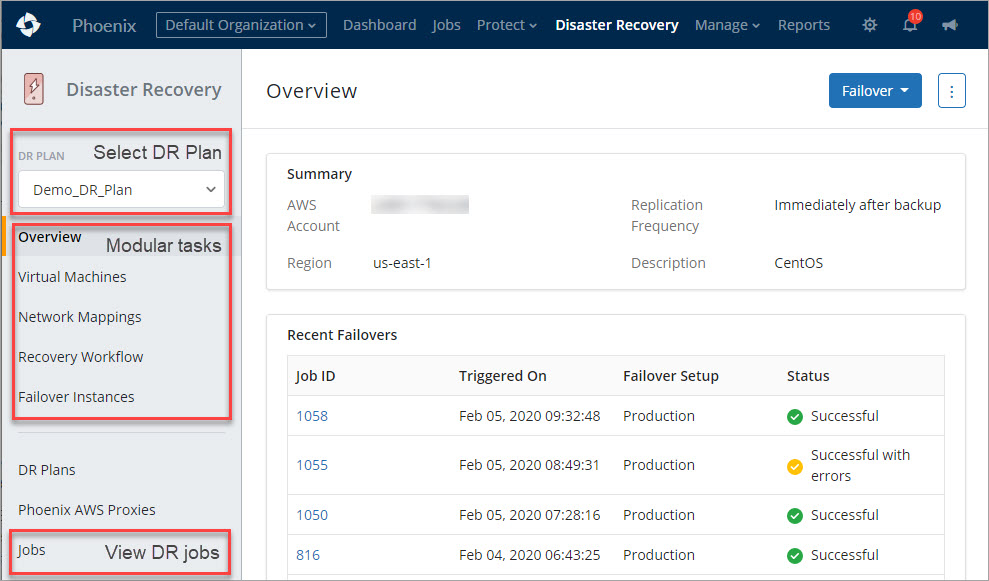
For more information, see Manage disaster recovery plan.
Ability to rename virtual machines during restore
Now while restoring your virtual machines to an alternate location, you can rename your virtual machines. This capability is available for a full restore of virtual machines and application-aware restores (currently involves restores of full VM).
For more information see, Restore VMware virtual machine to an alternate location.
The Recovered VM Name option is added.
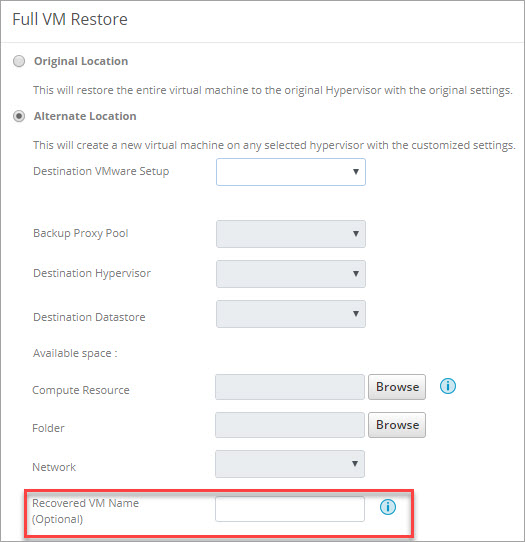
Alert for insufficient datastore free space during restore
While restoring your virtual machines to an alternate location, you will now receive an alert if there is insufficient free space on the destination datastore. This capability is available for a full restore of virtual machines and application-aware restores (currently involves restores of full VM).
For more information see, Restore VMware virtual machine to an alternate location.
The alert is displayed with the Available space field.
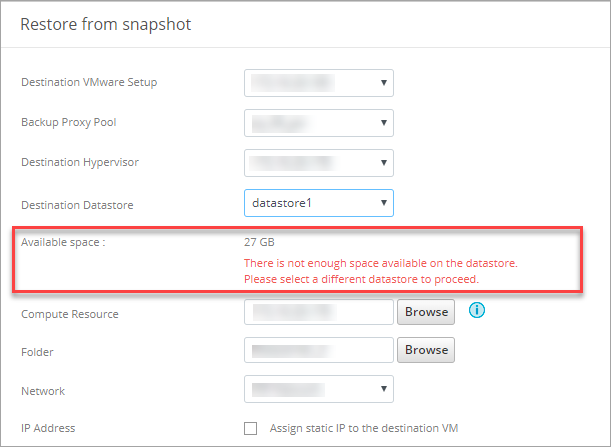
Revision Information
The following table lists the versions of the agents released:
| Platform | Revision | Public Cloud | Gov Cloud |
|---|---|---|---|
| Windows | 4.8.11-87541 |
|
|
| Linux | 4.8.11-87541 | ||
| VMware Backup Proxy | 4.8.11_87483 | ||
| Hyper-V FLR Proxy | Not applicable | ||
| Phoenix Backup Store | Not applicable |
February 03, 2020
New Features
Support for new file types for Windows/Linux servers and NAS
Druva Phoenix now supports two new categories of file types that you can include in or exclude from your backups for Windows/Linux servers and NAS.
| New Category | New file types |
|---|---|
| All Office files | Everything in the Office files category and .mpt, .xlt, .vdx, .vssm, .vsdx, .vsdm, .vtx, .xsn, .one, .pot, .vsd, .dotm, .vsl, .vsw, .vst, .vss, .vsx, .dot, .potm, .vssx, .potx, .vstm, .pub, .vstx |
| All Executables | Everything in the Executables category and .exec, .osx, .ps1, .sh, .bat, .cmd, .app, .dmg, .pkg, .rpm, .deb |
For more information, see About Phoenix for File server and About Phoenix for NAS shares.
No user action required.
Role-based access to API credentials
Druva Phoenix introduces access controls for effective and secured utilization of Druva APIs in your organization. While generating API credentials on the Druva Cloud Platform, Druva Cloud Administrators can now assign API accesses to inSync cloud administrators and Phoenix cloud administrators including view-only cloud and custom cloud administrators.
For more information, see Apply authorization restrictions.
Automated, centralized ticket creating system using ServiceNow
With this release, the integration of the ServiceNow app with Druva helps you automate the ticket creation workflow for Druva Phoenix backup failures. Now, get quick updates using the Druva ServiceNow app about any failed backup activities within Phoenix without the need to log in to the Phoenix Management Console or waiting for an email.
Key features
-
Ability to configure a threshold count for back-to-back failed backup activities.
-
Support for automatic ticket creation in case the defined threshold is breached.
For more information, see How to configure Druva Servicenow app.
Improve your backup and restore performance with the new Phoenix agent for File Server
This release brings an enhanced version of the Phoenix agent for File Server. We have added new, client-side architectural changes that significantly improve the backup and restore throughput.
Performance improvement observed during the internal tests performed:
- The first and incremental backups on Windows is 3x faster
- The first and incremental backups on Linux is 1.5x faster
- Restore on Windows and Linux is 3x faster
Customer action required: To experience the enhanced performance, contact Druva Support.
Revision Information
The following table lists the versions of the agents released:
| Platform | Revision | Public Cloud | Gov Cloud |
|---|---|---|---|
| Windows | 4.8.10-86228 |
|
|
| Linux | 4.8.10-86228 | ||
| VMware Backup Proxy | 4.8.10-86228 | ||
| Hyper-V FLR Proxy | 4.8.10-86228 | ||
| Phoenix Backup Store | Not applicable |
January 21, 2020
Enhancement
Improve your backup and restore performance with the new Phoenix agent for Microsoft SQL Server
This release brings an enhanced version of the Phoenix agent for Microsoft SQL Server. We have added new, client-side architectural changes that significantly improve the backup and restore throughput.
Performance improvement observed during the internal tests performed:
-
The first backup was 1.25x faster
-
The differential backup was 2x faster
Customer action required: We recommend you to upgrade to the latest version of Phoenix agent to experience the performance improvement. The system requirements to run the latest version of Phoenix agent are:
-
CPU Cores: 3
-
RAM: 3 gigabytes (GB)
Improve your backup and restore performance with the new Phoenix NAS agent
This release brings an enhanced version of the Phoenix NAS agent. We have added new, client-side architectural changes that significantly improve the backup and restore throughput.
Performance improvement observed during the internal tests performed:
-
The first and incremental backup on Windows was 5x faster
-
Restore on Windows and Linux was 3x faster
Customer action required: We recommend you to upgrade to the latest version of Phoenix agent to experience the performance improvement. The system requirements to run the latest version of Phoenix agent are:
-
CPU Cores: 3
-
RAM: 3 gigabytes (GB)
Revision Information
The following table lists the versions of the agents released:
| Platform | Revision | Public Cloud | Gov Cloud |
|---|---|---|---|
| Windows | 4.8.10-85833 |
|
|
| Linux | 4.8.10-85833 | ||
| VMware Backup Proxy | 4.8.10-85833 | ||
| Hyper-V FLR Proxy | 4.8.10-85833 | ||
| Phoenix Backup Store | Not applicable |
January 6, 2020
Enhancements
Restore Microsoft SQL Server databases on VMware virtual machines with static IPs
You can now restore the databases associated with VMware virtual machines with static IPs.
Customer action required: During restore, assign a different IP address for the destination VMware virtual machine.
For more information, see Restore Microsoft SQL Server databases on VMware virtual machines.
Improve your backup and restore performance with the new Phoenix NAS agent
This release brings an enhanced version of the Phoenix NAS agent. We have added new, client-side architectural changes that significantly improve the backup and restore throughput.
Performance improvement observed during the internal tests performed:
-
The first backup on Windows was 2x faster
-
Restore on Windows and Linux was 3x faster
Customer action required: We recommend you to upgrade to the latest version of Phoenix agent to experience the performance improvement. Here is what it takes to upgrade to the latest version of Phoenix agent:
-
CPU Cores: 3
-
RAM: 3 gigabytes (GB)
Change in support of the minimum system requirements of File Server, NAS, MS-SQL, and Hyper-V agents
The upcoming Phoenix release will bring an enhanced version of the Phoenix agent for File Server, MS-SQL, and Hyper-V.
Customer action required:
Here is what it takes to upgrade to the latest version of Phoenix agent:
-
CPU Cores: 3
-
RAM: 3 gigabytes (GB)
Warning: Upgrades and new installations of the File Server, NAS, MS-SQL, and Hyper-V agents will be blocked from January 20, 2020, onwards, for systems that do not meet the minimum system requirement.
Support for Oracle Linux 7.7 (File Server and NAS Proxy)
With this release, Phoenix provides you the ability to backup and restore files and folders on Oracle Linux 7.7. Moreover, you can also deploy NAS Proxy on Oracle Linux 7.7. For more information, see the support matrix.
Customer action required: No action required
View files that were skipped or missed during backup of NAS workloads
With this release, Phoenix makes it easier for you to view the list of files that have been skipped from the backup. The log folder contains a new ‘Phoenix-<JobID>-MissedFiles.log’ file that lists the skipped and missed files during a backup.
Revision Information
The following table lists the versions of the agents released:
| Platform | Revision | Public Cloud | Gov Cloud |
|---|---|---|---|
| Windows | 4.8.9-84646 |
|
|
| Linux | 4.8.9-84646 | ||
| VMware Backup Proxy | 4.8.9-84646 | ||
| Hyper-V FLR Proxy | Not applicable | ||
| Phoenix Backup Store | Not applicable |


